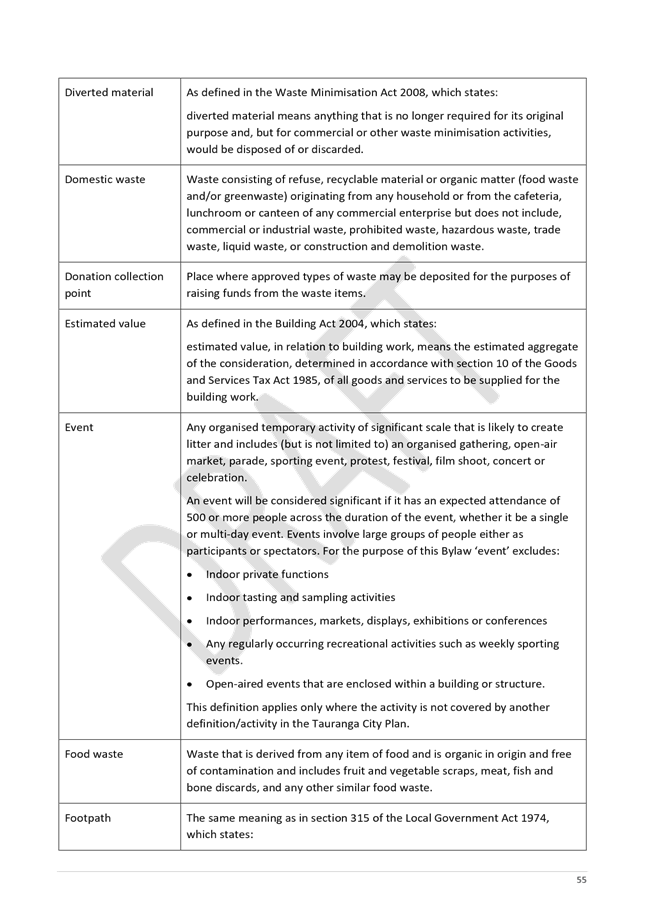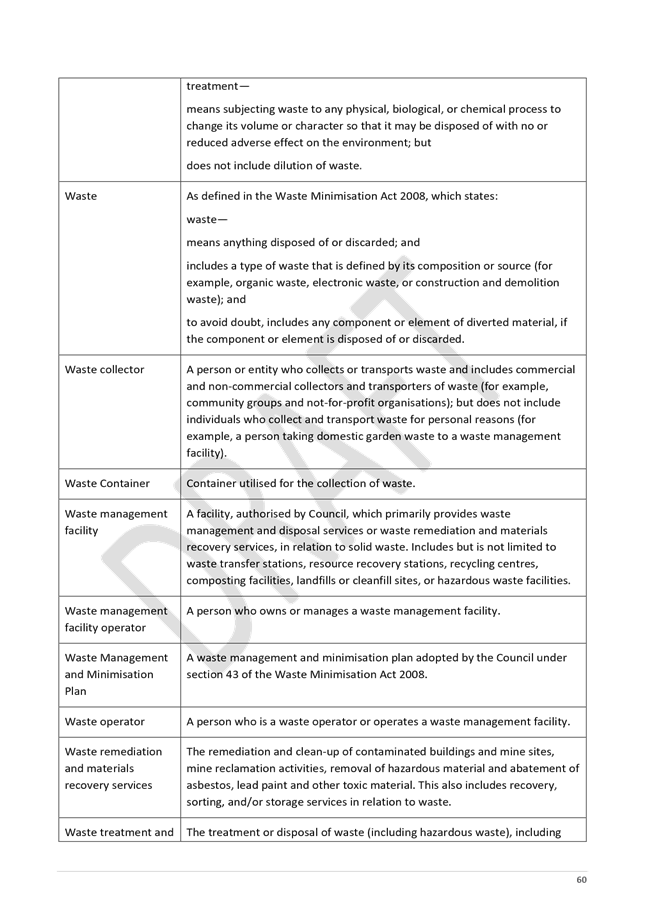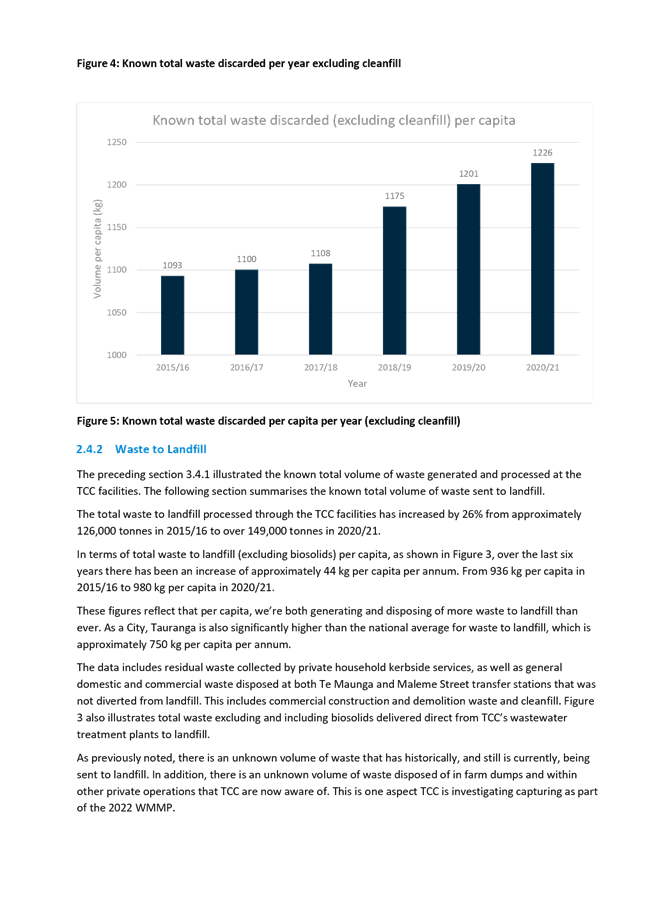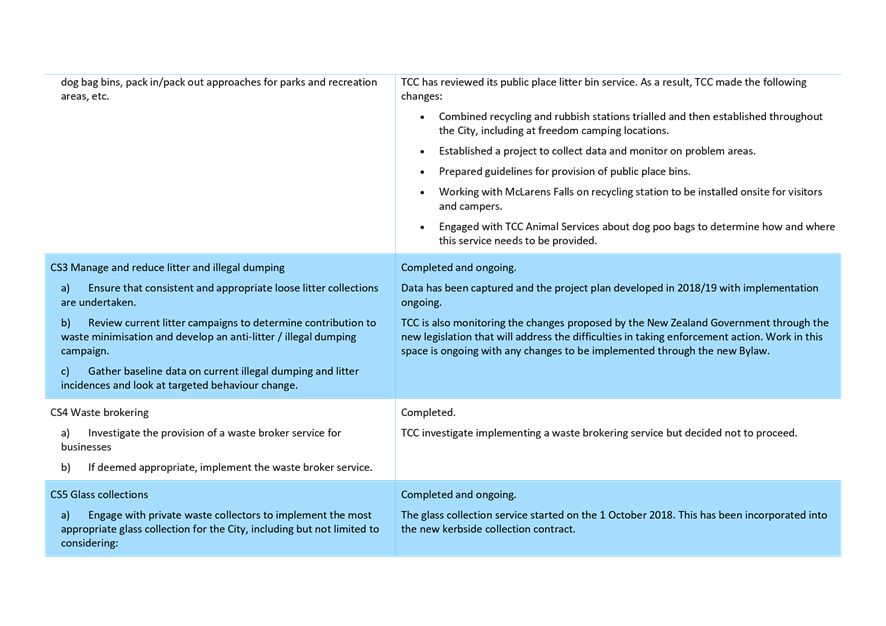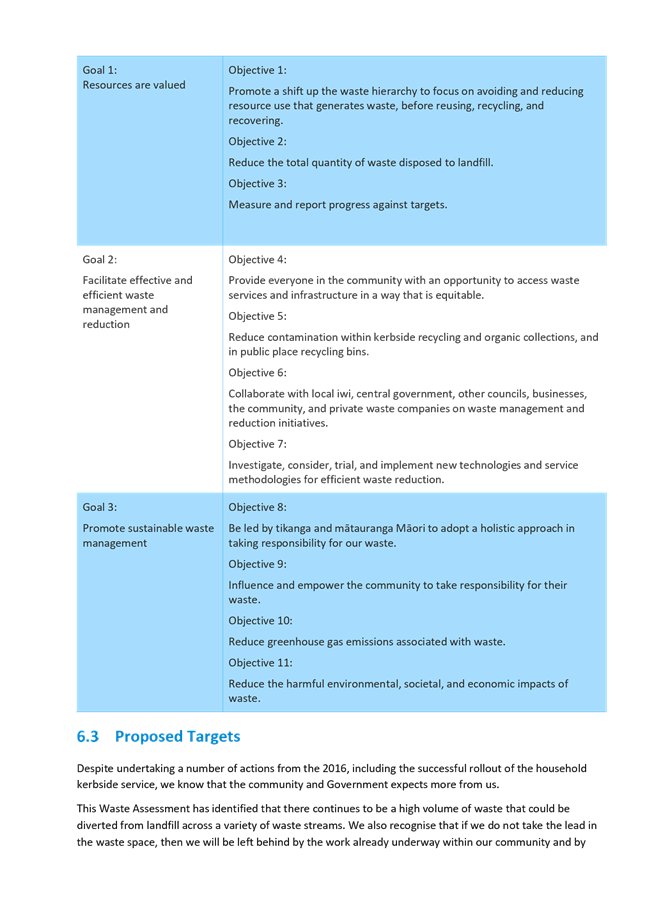|

|
|
AGENDA
Strategy, Finance and Risk Committee Meeting
Monday, 28 March 2022
|
|
I hereby give notice that a Strategy, Finance and
Risk Committee Meeting will be held on:
|
|
Date:
|
Monday, 28 March 2022
|
|
Time:
|
10.00am
|
|
Location:
|
Bay of Plenty Regional Council Chambers
Regional House
1 Elizabeth Street
Tauranga
|
|
Please note that this
meeting will be livestreamed and the recording will be publicly available on
Tauranga City Council's website: www.tauranga.govt.nz.
|
|
Marty Grenfell
Chief Executive
|
Terms of reference – Strategy,
Finance & Risk Committee
Membership
|
Chairperson
|
Commission Chair Anne Tolley
|
|
Deputy chairperson
|
Dr Wayne Beilby – Tangata
Whenua representative
|
|
Members
|
Commissioner Shadrach Rolleston
Commissioner Stephen Selwood
Commissioner Bill Wasley
|
|
|
Matire
Duncan, Te Rangapū Mana Whenua o Tauranga Moana Chairperson
Te Pio Kawe – Tangata
Whenua representative
Rohario Murray – Tangata
Whenua representative
Bruce
Robertson – External appointee with finance and risk
experience
|
|
Quorum
|
Five
(5) members must be physically present, and at least three (3) commissioners
and two (2) externally appointed members must be present.
|
|
Meeting frequency
|
Six weekly
|
Role
The role of the Strategy, Finance and Risk Committee (the
Committee) is:
(a)
to assist and advise the Council in discharging
its responsibility and ownership of health and safety, risk management,
internal control, financial management practices, frameworks and processes to
ensure these are robust and appropriate to safeguard the Council’s staff
and its financial and non-financial assets;
(b)
to consider strategic issues facing the city and
develop a pathway for the future;
(c)
to monitor progress on achievement of desired
strategic outcomes;
(d)
to review and determine the policy and bylaw framework
that will assist in achieving the strategic priorities and outcomes for the
Tauranga City Council.
Membership
The Committee will consist of:
·
four commissioners with the Commission Chair
appointed as the Chairperson of the Committee
·
the Chairperson of Te
Rangapū Mana Whenua o Tauranga Moana
·
three tangata whenua representatives
(recommended by Te Rangapū Mana Whenua o Tauranga
Moana and appointed by Council)
·
an independent external person with finance and
risk experience appointed by the Council.
Voting
Rights
The tangata whenua representatives and the independent
external person have voting rights as do the Commissioners.
The Chairperson of Te Rangapu Mana Whenua o Tauranga Moana
is an advisory position, without voting rights, designed to ensure mana whenua
discussions are connected to the committee.
Committee’s
Scope and Responsibilities
A. STRATEGIC ISSUES
The
Committee will consider strategic issues, options, community impact and explore
opportunities for achieving outcomes through a partnership approach.
A1 – Strategic Issues
The Committee’s
responsibilities with regard to Strategic Issues are:
·
Adopt an annual work
programme of significant strategic issues and projects to be addressed. The
work programme will be reviewed on a six-monthly basis.
·
In respect of each
issue/project on the work programme, and any additional matters as determined
by the Committee:
·
Consider existing
and future strategic context
·
Consider
opportunities and possible options
·
Determine preferred direction
and pathway forward and recommend to Council for inclusion into strategies,
statutory documents (including City Plan) and plans.
·
Consider and approve
changes to service delivery arrangements arising from the service delivery
reviews required under Local Government Act 2002 that are referred to the
Committee by the Chief Executive.
·
To take appropriate
account of the principles of the Treaty of Waitangi.
A2 – Policy and Bylaws
The Committee’s
responsibilities with regard to Policy and Bylaws are:
·
Develop, review and
approve bylaws to be publicly consulted on, hear and deliberate on any
submissions and recommend to Council the adoption of the final bylaw. (The
Committee will recommend the adoption of a bylaw to the Council as the Council
cannot delegate to a Committee the adoption of a bylaw.)
·
Develop, review and
approve policies including the ability to publicly consult, hear and deliberate
on and adopt policies.
A3 – Monitoring of Strategic
Outcomes and Long Term Plan and Annual Plan
The Committee’s
responsibilities with regard to monitoring of strategic outcomes and Long Term
Plan and Annual Plan are:
·
Reviewing and
reporting on outcomes and action progress against the approved strategic
direction. Determine any required review/refresh of strategic direction or
action pathway.
·
Reviewing and
assessing progress in each of the six (6) key investment proposal areas within
the 2021-2031 Long Term Plan.
·
Reviewing the
achievement of financial and non-financial performance measures against the
approved Long Term Plan and Annual Plans.
B.
FINANCE AND RISK
The Committee will review the
effectiveness of the following to ensure these are robust and appropriate to
safeguard the Council’s financial and non-financial assets:
·
Health and safety.
·
Risk management.
·
Significant projects and programmes of work
focussing on the appropriate management of risk.
·
Internal and external audit and assurance.
·
Fraud, integrity and investigations.
·
Monitoring of compliance with laws and regulations.
·
Oversight of preparation of the Annual Report
and other external financial reports required by statute.
·
Oversee the relationship with the
Council’s Investment Advisors and Fund Managers.
·
Oversee the relationship between the Council and
its external auditor.
·
Review the quarterly financial and non-financial
reports to the Council.
B1 - Health and Safety
The Committee’s responsibilities through regard to
health and safety are:
·
Reviewing the effectiveness of the health and
safety policies and processes to ensure a healthy and safe workspace for
representatives, staff, contractors, visitors and the public.
·
Assisting the Commissioners to discharge their
statutory roles as “Officers” in terms of the Health and Safety at
Work Act 2015.
B2 - Risk Management
The Committee’s responsibilities with regard to risk
management are:
·
Review, approve and monitor the implementation of the Risk
Management Policy, Framework and Strategy including the Corporate Risk
Register.
·
Review and approve the Council’s “risk
appetite” statement.
·
Review the effectiveness of risk management and internal control
systems including all material financial, operational, compliance and other
material controls. This includes legislative compliance, significant projects
and programmes of work, and significant procurement.
·
Review risk management reports identifying new and/or emerging
risks and any subsequent changes to the “Tier One” register.
B3
- Internal Audit
The Committee’s responsibilities with regard to the
Internal Audit are:
·
Review and approve the Internal Audit Charter to confirm the
authority, independence and scope of the Internal Audit function. The Internal
Audit Charter may be reviewed at other times and as required.
·
Review and approve annually and monitor the implementation of the
Internal Audit Plan.
·
Review the co-ordination between the risk and internal audit
functions, including the integration of the Council’s risk profile with
the Internal Audit programme. This includes assurance over all material
financial, operational, compliance and other material controls. This includes
legislative compliance (including Health and Safety), significant projects and
programmes of work and significant procurement.
·
Review the reports of the Internal Audit functions dealing with
findings, conclusions and recommendations.
·
Review and monitor management’s responsiveness to the
findings and recommendations and enquire into the reasons that any
recommendation is not acted upon.
B4
- External Audit
The Committee’s responsibilities with regard to the
External Audit are:
·
Review with the external auditor, before the audit commences, the
areas of audit focus and audit plan.
·
Review with the external auditors, representations required by
commissioners and senior management, including representations as to the fraud
and integrity control environment.
·
Recommend adoption of external accountability documents (LTP and
annual report) to the Council.
·
Review the external auditors, management letter and management
responses and inquire into reasons for any recommendations not acted upon.
·
Where required, the Chair may ask a senior representative of the
Office of the Auditor General (OAG) to attend the Committee meetings to discuss
the OAG’s plans, findings and other matters of mutual interest.
·
Recommend to the Office of the Auditor General the decision
either to publicly tender the external audit or to continue with the existing
provider for a further three-year term.
B5
- Fraud and Integrity
The Committee’s responsibilities with regard to
Fraud and Integrity are:
·
Review and provide advice on the Fraud Prevention and Management
Policy.
·
Review, adopt and monitor the Protected Disclosures Policy.
·
Review and monitor policy and process to manage conflicts of
interest amongst commissioners, tangata whenua representatives, external representatives
appointed to council committees or advisory boards, management, staff,
consultants and contractors.
·
Review reports from Internal Audit, external audit and management
related to protected disclosures, ethics, bribery and fraud related incidents.
·
Review and monitor policy and processes to manage
responsibilities under the Local Government Official Information and Meetings
Act 1987 and the Privacy Act 2020 and any actions from the Office of the
Ombudsman’s report.
B6
- Statutory Reporting
The
Committee’s responsibilities with regard to Statutory Reporting relate to
reviewing and monitoring the integrity of the Annual Report and recommending to
the Council for adoption the statutory financial statements and any other
formal announcements relating to the Council’s financial performance,
focusing particularly on:
·
Compliance with, and the appropriate application of, relevant
accounting policies, practices and accounting standards.
·
Compliance with applicable legal requirements relevant to
statutory reporting.
·
The consistency of application of accounting policies, across
reporting periods.
·
Changes to accounting policies and practices that may affect the
way that accounts are presented.
·
Any decisions involving significant judgement, estimation or
uncertainty.
·
The extent to which financial statements are affected by any
unusual transactions and the manner in which they are disclosed.
·
The disclosure of contingent liabilities and contingent assets.
·
The basis for the adoption of the going concern assumption.
·
Significant adjustments resulting from the audit.
Power
to Act
·
To make all
decisions necessary to fulfil the role, scope and responsibilities of the
Committee subject to the limitations imposed.
·
To establish
sub-committees, working parties and forums as required.
·
This Committee has not
been delegated any responsibilities, duties or powers that the Local Government
Act 2002, or any other Act, expressly provides the Council may not
delegate. For the avoidance of doubt, this Committee has not
been delegated the power to:
o
make a rate;
o
make a bylaw;
o
borrow money, or purchase
or dispose of assets, other than in accordance with the Long Term Plan (LTP);
o
adopt the LTP or Annual
Plan;
o
adopt the Annual Report;
o
adopt any policies required
to be adopted and consulted on in association with the LTP or developed for the
purpose of the local governance statement;
o
adopt a remuneration and
employment policy;
o
appoint a chief executive.
Power
to Recommend
To Council and/or any standing committee
as it deems appropriate.
8 Business
8.1 Mainstreets
Monitoring Report for the period to 31 December 2021
File Number: A13171629
Author: Anne
Blakeway, Manager: Community Partnerships
Authoriser: Gareth
Wallis, General Manager: Community Services
Purpose
of the Report
1. For
mainstreet organisations to report to Council on their activities for the
period July to December 2021, to highlight issues, to provide a financial
update, and to outline plans for future activities.
|
Recommendations
That the Strategy,
Finance and Risk Committee:
(a) Receives the
Mainstreets’ Monitoring Report for the period to 31 December 2021.
(b) Receives the Mount Business
Association Report to 31 December 2021.
(c) Receives the Mainstreet
Tauranga Report to 31 December 2021.
(d) Receives the Greerton
Village Mainstreet Report to 31 December 2021.
(e) Receives
the Papamoa Unlimited Report to 31 December 2021.
|
Executive
Summary
2. Mainstreet
organisations receive a targeted rate through Council.
3. As
part of Council’s agreement with the four mainstreet organisations, they
are required to report every six months on activities achieved, activities
planned, and any issues they want to bring to the attention of Council. They
are expected to provide a financial update for each reporting period and
audited financials after the end of the financial year.
4. This
report reflects the period 1 July to 31 December 2021.
5. A
summary of performance – both financial and non-financial – is
provided for Mainstreet Tauranga, Greerton Village Mainstreet, Mount Business
Association and Papamoa Unlimited. All mainstreet organisations are in good
financial health.
6. Notwithstanding
the ongoing challenges of COVID to foot traffic and event cancellations, the
mainstreet organisations appear to be having a positive effect on the
activation and economic vibrancy of their areas, largely through a number of events
and promotions.
7. Following
an independent review of the four mainstreet organisations, on 15 November 2021
Council approved the appointment of a 0.5FTE City Partnerships Specialist who
would provide one point of contact for mainstreets within Tauranga City Council
(TCC).
8. The
appointee to this role will commence on 14 March 2022, and will begin work on
developing and implementing a new accountability regime, including the
development of a letter of expectation as the mechanism for ensuring strategic
alignment between the mainstreet organisations and TCC. They will also review
the existing arrangements with the mainstreet organisations to reflect the
proposed accountability regime and to standardise, where possible, the
terminology in the agreements.
Background
9. There
are agreements in place between TCC and the four mainstreet organisations for
the delivery of services. The intent of the agreements is to the effect that:
· The
mainstreet organisations will contribute to the achievement of a strong and
vibrant city and town centres, by promoting the appeal of their respective
areas to residents and visitors through events, promotions, and other means.
· That
TCC will provide funding for these mainstreet services by way of a targeted
rate on commercial property within each of the respective mainstreet business
areas.
· The
mainstreet organisations are incorporated societies and all business operators
within their respective targeted rates areas are regarded by the mainstreet organisations
as being their members.
Discussion
10. Audited
financial accounts were due from all mainstreet organisations by 28 January
2022.
11. Financial
statements provided by Mainstreet Tauranga, Papamoa Unlimited and Greerton
Village Mainstreet indicate that they are in good financial health, showing
annual operating surpluses and positive equity.
12. Mount
Business Association made a net loss of $21,947 over the last six months due to
the Board approving additional spend, above normal operating expenses, for
specific initiatives to improve service to their members. This was taken out of
reserves left over from previous years’ underspend and supports the
greater level of activity now taking place compared to previous years.
13. Activities
undertaken by all mainstreet organisations appear to be having a positive
effect on the activation and economic vibrancy of their areas, largely through
events and promotions.
14. Please
see Attachment 1 for a summary of the mainstreet reports, including issues to
present to Council.
Mount Business Association:
a) The current agreement for
the delivery of mainstreet services has been in place since 1 July 2009.
Funding of $188,550 from targeted rates is provided by TCC under the agreement
for the year ended 30 June 2022.
b) It is pleasing to see that
Mount Business Association has undertaken a significant self-review, which has
led to the development of a new constitution and destination marketing
strategic plan (Attachment 2), which outlines how the targeted rate will be
spent on marketing, activations, and member engagement.
c) A Destination Marketing
Manager has been appointed on a 25 hours per week contract, along with an
Operations Manager working 4 – 6 hours per week. In addition, Kate
Barry-Piceno (Mauao Legal Chambers) has been appointed to chair a new Board.
d) Members have stuck it out
through the various COVID restrictions and have been rewarded with record
summer trading.
e) A number of events and
promotions have been rolled out in the first half of the year, which has proved
there is demand from the public and members for events to be held down the mainstreet,
especially those with a family focus.
f) Highlights include
the July school holiday ice rink, Christmas activations including the Mount
Music Trail. Further details can be found in the Mount Business Association
Six-Month Monitoring Report and Profit and Loss statement for July to December
2021 (Attachment 3).
g) The “Welcome to
Paradise” marketing campaign will help drive a hyper-local approach to
promoting Mount Maunganui and its mainstreet to identified target audiences,
and growing brand awareness.
h) Key issues include street
cleanliness, overflowing rubbish bins and member engagement. This will be a
major focus over the coming year, including rebuilding trust with old members
while helping new members understand the role of the association in supporting
their business and creating a connected community.
i) Mount Business
Association looks forward to working with the new City Partnerships Specialist
to develop some clear Key Performance Indicators (KPIs) but have provided a
draft of initial thinking in Attachment 4.
Mainstreet Tauranga:
a) The
current agreement for the delivery of mainstreet services has been in place
since 1 July 2009. Funding of $353,934 from targeted rates is provided by TCC
under the agreement for the year ended 30 June 2022.
b) Mainstreet
Tauranga contracts Tuskany Agency for the day-to-day management and delivery of
the mainstreet programme in downtown Tauranga. The Tuskany Agency Manager
reports to the Board of Mainstreet Tauranga.
c) Highlights
from the last six months include Trustpower Toi Tauranga Christmas, member
promotion and support during the COVID lockdown period, and continued
achievements with activating vacant spaces. Further details can be found
in Mainstreet Tauranga’s Six-Month Monitoring Report and Profit and Loss
statement for July to December 2021 (Attachment 5).
d) Special
mention is made of James Wilson and TCC’s support for Christmas in the
city centre, and the addition of the curated collection of light sculptures and
installations on The Strand by internationally acclaimed artist, Anguis Muir.
This resulted in increased foot traffic around the city and on The Strand,
especially at night, and is something members would like to see more of.
e) Key issues for
Mainstreet Tauranga are:
· Seismic strengthening of Elizabeth and Spring Street car
park buildings.
· Lack of foot traffic counters, despite budget being
allocated to Tauranga Traffic Operations Centre (TTOC) in the Long-term Plan.*
· Accurate city centre parking data collection.
· New
initiatives from Council to replace Activate Vacant Spaces.
· Rough
sleeping issues with one individual – since resolved.
* An update from TTOC
indicates that 17 foot traffic counters have been installed and are now operational
and collecting data (see below). The Asset Management team are trying to fill a
vacancy for a data scientist to turn the data into a dashboard. This has been
communicated to Mainstreet Tauranga staff.

Greerton Village Mainstreet:
a) The current agreement for
the delivery of mainstreet services has been in place since 1 July 2011.
Funding of $134,672 from targeted rates is provided by TCC under the agreement
for the year ended 30 June 2022.
b) Greerton Village
Mainstreet employs a manager who is responsible to the organisation’s
Board for the day-to-day delivery of the mainstreet programme in Greerton,
including a range of events and promotions designed to attract people to the
Greerton business area.
c) This reporting period has
been a particularly challenging one for Greerton Village Mainstreet, with the
cancellation of many planned events and promotions mainly due COVID
restrictions, and a downturn in foot traffic and turnover for mainstreet
businesses. Further details can be found in the Greerton Village Mainstreet
Six-Month Monitoring Report and Profit and Loss statement for July to December
2021 (Attachment 6).
d) Highlights include the
Yarn Bombing installations in July, the Christmas lights (installed by
volunteers), and the support of over 60 businesses for the Giant Christmas
Hamper promotion.
e) There continue to be issues with pavement
deep cleaning, street cleaning, and streetlight cleaning. While the TCC
Transportation team are now working with Greerton Village Mainstreet on ongoing
‘tidy-up’ maintenance work, including streetlights, pavements, and
benches, this has taken much longer than Greerton Village Mainstreet had hoped,
leaving them feeling like the “poor relations”.
f) On the plus side, Greerton Village
Mainstreet has received great service from TCC and contractors re the
installation of additional CCTV cameras and checking of garden sockets.
Papamoa Unlimited:
a) The current agreement for
the delivery of mainstreet services has been in place since 1 July 2014.
Funding of $50,000 from targeted rates is provided by TCC under the agreement
for the year ended 30 June 2022.
b) Papamoa Unlimited is
managed by a volunteer chair who engages a contractor to assist with the
running of events. The sole focus of Papamoa Unlimited is to hold three or four
community events each year. An element of each event occurs within the Papamoa
business area and as such, attracts people to that location and in doing so,
promotes the business area as well as the vibrancy of Papamoa generally.
c) Highlights for this period include Pedal
and Pump and Santa’s Jolly Good Fellows. Financial results impacted by
the cancellation of events due to the uncertainty of changing alert levels and
corresponding restrictions on numbers. Further details can be found in the
Papamoa Unlimited Six-Month Monitoring Report and Profit and Loss statement for
July to December 2021 (Attachment 7).
d) No increase in the targeted business rate
was recommended or sought at the AGM. Papamoa Unlimited feels that its business
model ensures agility, which has proven to be beneficial during the COVID
pandemic.
Strategic / Statutory
Context
15. The City Centre
Strategy (2012), which is currently under review, is relevant to Mainstreet
Tauranga to the extent that its vision is to create a thriving commercial
centre. Specific actions may be assigned to Mainstreet Tauranga to implement as
a key strategy stakeholder.
16. In terms of
TCC’s community outcomes that were in the Long-term Plan 2021-2031,
well-run mainstreet programmes make a worthwhile contribution to city centre
vibrancy and to “a city that is well planned with a variety of
successful and thriving compact centres and resilient infrastructure.”
17. Well-run mainstreet programmes
also have a key role in making a significant contribution “to
the social, economic, cultural and environmental well-being of the
region.”
Financial Considerations
18. Mainstreet
organisations receive a targeted rate through Council, as detailed above,
totalling $727,156 per annum across the four organisations.
19. It is difficult to
measure the outcomes achieved by the mainstreet programmes in economic terms,
meaning that generally only anecdotal and informal measures of success are
available. However, informal measures, such as estimated numbers of people
attending events, to determine if customer foot traffic or turnover was
improved by events and promotions etc., are useful, providing they are
objective.
20. One task for the new City Partnerships
Specialist will be to undertake independent surveys of retailers as a method of
determining the success of the mainstreet programmes.
Legal Implications /
Risks
21. Each
of the mainstreet organisations has met their funding agreement requirements by
providing Council with their half yearly reports for 1 July 2021 to 31 December
2021.
Consultation /
Engagement
22. It
is not required or expected to consult on half yearly reports under the Local
Government Act 2002.
Significance
23. The Local
Government Act 2002 requires an assessment of the significance of matters,
issues, proposals and decisions in this report against Council’s Significance
and Engagement Policy. Council acknowledges that in some
instances a matter, issue, proposal, or decision may have a high degree of
importance to individuals, groups, or agencies affected by the report.
24. In
making this assessment, consideration has been given to the likely impact, and
likely consequences for:
(a) the current and future social,
economic, environmental, or cultural well-being of the district or region
(b) any
persons who are likely to be particularly affected by, or interested in, the
matter.
(c) the capacity of the local authority to
perform its role, and the financial and other costs of doing so.
25. In
accordance with the considerations above, criteria and thresholds in the
Significance and Engagement Policy, it is considered that the decision is of
low significance as the receipt of the half yearly reports and the activities
of the mainstreet organisations would have an impact on a sub group of people
within the city and it is likely these documents will be of moderate public
interest.
ENGAGEMENT
26. Taking
into consideration the above assessment, that the matter is of low significance,
officers are of the opinion that no further engagement is required prior to
Council making a decision.
Next Steps
27. Feedback
will be provided to the mainstreet organisations at the Strategy, Finance and
Risk Committee meeting on 28 March 2022, when representatives from each of the
mainstreets will talk to their reports (for a maximum of 10 minutes).
28. The
City Partnerships Specialist commences on 14 March 2022 and will begin work on
developing and implementing a new accountability regime (including new KPIs),
as outlined in the recent review of the mainstreets. This will include the
development of a letter of expectation as the mechanism for ensuring strategic
alignment between the mainstreet organisations and TCC.
29. The
City Partnerships Specialist will also review the existing arrangements with
the mainstreet organisations to reflect the proposed accountability regime, and
to standardise, where possible, the terminology in the agreements.
Attachments
1. Mainstreet
Monitoring Report - Summary for July to December 2021 - A13242895 ⇩ 
2. Mount
Business Association - Destinating Marketing Plan 2021/2022 - A13240926 ⇩ 
3. Mount
Business Association Monitoring Report - July to December 2021 - A13273617 ⇩ 
4. Mount
Business Association Draft KPIs - A13273618 ⇩ 
5. Mainstreet
Tauranga Monitoring Report - July to December 2021 - A13240903 ⇩ 
6. Greerton
Village Mainstreet Monitoring Report - July to December 2021 - A13273608 ⇩ 
7. Papamoa Unlimited
Monitoring Report - July to December 2021 - A13273619 ⇩ 
|
Strategy, Finance and Risk
Committee Meeting Agenda
|
28 March 2022
|


|
Strategy, Finance and Risk Committee
Meeting Agenda
|
28 March 2022
|



















|
Strategy, Finance and Risk Committee
Meeting Agenda
|
28 March 2022
|









|
Strategy, Finance and Risk Committee
Meeting Agenda
|
28 March 2022
|


|
Strategy, Finance and Risk Committee
Meeting Agenda
|
28 March 2022
|












|
Strategy, Finance and Risk Committee
Meeting Agenda
|
28 March 2022
|








|
Strategy, Finance and Risk Committee
Meeting Agenda
|
28 March 2022
|












8.2 Audit
New Zealand Report on the Audit of Tauranga City Council for the year ended 30
June 2021 and Audit Plan for the year ended 30 June 2022
File
Number: A13295052
Author: Kathryn
Sharplin, Manager: Finance
Authoriser: Paul
Davidson, General Manager: Corporate Services
Purpose
of the Report
1. This
report presents the Audit New Zealand report to the commissioners on the audit
of Tauranga City Council for the year ended 30 June 2021, along with council
comments on recommended improvements. The Plan for the audit of Tauranga
City Council for the year ended 30 June 2022 is also presented. Audit
Director Clarence Susan will be in attendance for discussion of any of the
matters raised in the report and attachments.
|
Recommendations
That the Strategy, Finance
and Risk Committee:
(a) Receives
the report - Audit New Zealand Report on the Audit of Tauranga City Council
for the year ended 30 June 2021 and Audit Plan for the year ended 30 June
2022
|
Executive
Summary
2. Audit
New Zealand has completed its audit of Tauranga City Council (TCC)for the year
ended 30 June 2021.
3. The
audit report outlines matters identified during the audit, makes
recommendations and includes council comments on these recommendations.
An update on matters identified during the previous audit are also provided.
4. Audit
New Zealand has also provided a plan for the audit of TCC for 2022. Focus
for this year continues to be assets including capitalisation including large
capital projects and digital investment relating to software as a service.
Background
5. Audit New Zealand
has completed its audit of TCC for the year ended 30 June 2021. An unmodified
audit opinion was given for the adoption of the 2021 Annual report on 15
December 2021, which included an emphasis of matter paragraph regarding the
Government’s announcement on the three waters reform programme.
6. The audit report
outlines matters identified during the audit, makes recommendations and
includes council comments on these recommendations. An update on matters
identified during the previous audit is also provided.
7. Audit
New Zealand provides recommendations for improvement and prioritises these as
urgent, necessary, or beneficial.
8. No
urgent recommendations were made. Eleven necessary recommendations were made as
outlined on pages 5 and 6 of the attached report. Of these, six related
to improvements related to asset and project accounting. The other 5 related to
a range of internal controls and processes across the business. Audit NZ
recommends that necessary recommendations are addressed within 6 months.
9. In
response to the identified matters and the challenges of delivering the annual
report, council has focussed additional resource in the asset and financial
accounting area. It is expected that some of the matters will be
addressed in time for the next annual report, while others will take longer to
implement. The very late adoption of the annual report in December 2021
has a flow on impact to the timing of improvements.
10. The
attached audit report includes council’s comments on proposed actions
against each of the new matters raised by Audit New Zealand.
The audit plan for 2022 identifies key matters for attention
during the Audit for the year to 30 June 2022. Focus for this year continues to
be on assets including:
1. treatment
of expenditure on software as a service and what we capitalise
2. accounting
for large capital projects – costs and whether they are operational or
capital in nature, and the timeliness of capitalisation
3. revaluations
of roading and marine assets
4. three
waters
5. confirmation
that other asset classes, particularly three waters, have not moved materially
from current values.
Strategic / Statutory
Context
11. The
audit report is part of the processes of Financial accounting and reporting set
out under the Local Government Act 2002.
Options Analysis
12. There
are no options presented in this report.
Financial Considerations
13. The
recommendations of the audit report include recommendations regarding asset
accounting and other internal controls and reporting requirements which will be
addressed by the finance team going forward.
Legal Implications /
Risks
14. There
are no specific legal implications or risks as a result of this report.
Consultation /
Engagement
15. There
is no consultation required as a result of this report.
Significance
16. The
Local Government Act 2002 requires an assessment of the significance of
matters, in this report against Council’s Significance and Engagement
Policy. Council acknowledges that in some instances a matter, may have a
high degree of importance to individuals, groups, or agencies affected by the
report.
17. In
making this assessment, consideration has been given to the likely impact, and
likely consequences for:
(a) the current
and future social, economic, environmental, or cultural well-being of the
district or region
(b) any persons who are likely to be
particularly affected by, or interested in, the .
(c) the capacity of the local authority to
perform its role, and the financial and other costs of doing so.
18. In
accordance with the considerations above, criteria and thresholds in the policy,
it is considered that the matter is of low significance.
ENGAGEMENT
19. Taking
into consideration the above assessment, that the matter is of low significance,
officers are of the opinion that no further engagement is required prior to Council
making a decision.
Next Steps
20. Council
will engage with Audit New Zealand on the interim and final audits of Tauranga
City Council in accordance with the agreed audit plan.
21. Council
will continue to work through recommendations for improvement in our processes
and reporting.
Attachments
1. Audit
New Zealand Tauranga City Council - Report to the Commissioners - 30 June 2021
- Final - A13308556 ⇩ 
2. Audit New Zealand
Tauranga City Council Audit Plan for 30 June 2022 - A13308560 ⇩ 
|
Strategy, Finance and Risk
Committee Meeting Agenda
|
28 March 2022
|






































|
Strategy, Finance and Risk Committee
Meeting Agenda
|
28 March 2022
|



























8.3 Adoption
of draft Rates Remission Policy and draft Rates Postponement Policy for
consultation
File
Number: A13167367
Author: Jim
Taylor, Transactional Services Manager
Emma Joyce, Policy Analyst
Authoriser: Paul
Davidson, General Manager: Corporate Services
Purpose
of the Report
1. To
adopt the draft Rates Remission Policy (attachment 1) and draft Rates
Postponement Policy (attachment 2) (the draft policies) for consultation.
|
Recommendations
That the Strategy,
Finance and Risk Committee:
(a) Adopt
the draft Rates Remission Policy for consultation
(b) Adopt
the draft Rates Postponement Policy for consultation.
|
Executive
Summary
2. In
general, all ratepayers are expected to pay rates. However, rates postponement
and remission policies allow Council to recognise financial or other special
circumstances where ratepayers may require support to manage their rates payments.
In adopting the Long-term Plan 2021-2031 (LTP) and in response to public
feedback, Commissioners requested a review of council policies on the remission
and postponement of rates, particularly for those on fixed incomes.
3. Recent
legislative changes also require councils to review their policies on rates
remission and postponement to confirm they support the principles in the
Preamble to Te Ture Whenua Māori Act 1993 (TTWMA 93).
4. The
Strategy, Finance and Risk Committee (the Committee) considered a range of
options to amend the policies at its February 2022 meeting. Those amendments
have now been incorporated into draft policies for adoption. This report
recommends the Committee adopt the draft policies for consultation.
Background
5. While
there are some exceptions outlined in legislation, in general, all land is
rateable. However, there may be circumstances where ratepayers need support to
manage their rates. Councils can choose to provide for rates postponement
(whereby rates are paid at an agreed later date) or remit rates (where council
forgoes rates income) through policies stating the objectives and criteria for
postponement or remission.
6. This
council has previously recognised a need to offer rates postponement where the
ratepayer is experiencing financial hardship, and to acknowledge that Council
decisions to rezone farmland may impact the rating valuation of a property
regardless of how the ratepayer prefers to use the property. The Committee
agreed at its February 2022 meeting to remove some criteria for accessing the
postponement for financial hardship and expand the provisions for farmland to
properties recently moved into Tauranga City Council area through a boundary
adjustment.
7. The
Committee also agreed at its February 2022 meeting to introduce a temporary
partial remission for gold kiwifruit orchards. This partial remission provides
for a transition to a new rating valuation that includes the value of the
licence to grow gold kiwifruit and the planted vines. However, a recent decision
from Gisborne held that the rating valuation of gold kiwifruit orchards should not
consider the value of the licence to grow gold kiwifruit. As this may impact on
how other councils rate gold kiwifruit orchards, the policy provides for gold
kiwifruit orchards to receive 100% remission of the portion of rates relating
to the capital value component of the G3 licence in year one.
8. A
copy of the February 2022 minutes are below.
That the
Strategy, Finance and Risk Committee:
(a) Notes
that reference to the Preamble to Te Ture Whenua Māori Act 1993 will be
added to Council’s Revenue and Financing Policy.
(b) Agree
that the following matters be addressed in a draft Rates Postponement Policy
for consultation (for adoption by Council);
(i) deletion of all criteria for rates
postponement for financial hardship except the requirement for there to be at
least 25% equity in the property and that the ratepayer must not be able to
access support from private sector financial institutions.
(ii) addition a new criterion that applications for
rates postponement for financial hardship may only be for the property the
ratepayer is currently residing in.
(iii) addition of a new criterion providing for postponement
of rates on rating units where the valuation may have increased due to boundary
adjustments and re-zoning from rural to urban uses, noting that a maximum of
six years postponed rates will be due when the property is sold or developed.
(c) Agree
that the following matters be addressed in a draft Rates Remission Policy for
consultation (for adoption by Council);
(i) Addition of a provision for
partial remission of general rates and targeted rates set at the capital value
on rating units with both a license to grow gold kiwifruit and planted vines
where the rates have increased by more than the citywide average, noting that
the remission will be for the portion of rates relating to the capital value
component of the G3 licence and for a maximum of three years with 100%
remission in the 2022/2023 financial year and two thirds remission in year two
(2023/2024).
(ii) Deletion of
provisions pertaining to remission of wastewater rates for schools and
reference to remission of rates on land designated a Māori reservation.
9. The
draft policies also include an additional principle acknowledging that while
all ratepayers are required to pay rates, there may be circumstances where
ratepayers need additional support to manage payments. These principles are
consistent with the overarching principles in the Revenue and Financing Policy.
10. These
amendments are highlighted in the attached draft policies.
Options Analysis
11. The
Committee could choose to adopt the draft policies with or without amendments,
or not adopt the draft policies. The table below outlines the advantages and
disadvantages of each option.
|
Option
|
Advantages
|
Disadvantages
|
|
1
|
Adopt
the draft policies
(recommended)
|
· Consistent with
amendments approved in February 2022
· Ensures policies
are reviewed prior to 2024 to assess compliance with TTWMA 93
· Provides for
rates remission on gold kiwifruit orchards while implications
|
· Nil
|
|
2
|
Adopt
the draft policies with amendments
|
· ·
| 3 |
Do not
adopt the draft policies
|
· Nil
|
· Constrained
timeframes to consult with public before next financial year
|
Other matters
Rates Postponement Policy
12. The
draft Rates Postponement Policy includes a minor edit to make it clearer that
postponed rates are due on the sale of the property. The current wording could
be interpreted to mean that a property could be sold but the rates could
continue to be postponed if no consent in line with the revised zoning is
issued.
Rates
Remission Policy
13. As
part of the review, adjustments have been made to the amount of rates penalty
that may be remitted upon application. This means that staff will remit
penalties where the penalty is less than $50 for general rates and less than $5
for water rates. These adjustments recognise the administrative cost of
processing penalties for relatively low amounts while also providing some
relief to ratepayers.
14. In
response to feedback received from the Committee at its February 2022 meeting,
the principles have been amended to add reference to fairness and equity.
15. Minor
amendments to the draft policies have been made to include TTWMA 93 and the
Rating Valuations Act 1998 in the list of related legislation.
Strategic / Statutory
Context
16. Section 102 of the Local
Government Act 2002 allows councils to adopt policies on the remission and
postponement of rates. Where councils have adopted such policies, they must be
reviewed prior to 1 July 2024 to confirm that they support the principles in
TTWMA 93.
Financial Considerations
17. There
are no financial considerations with the recommended option.
18. Council
seeks to recover some of the costs of postponement through the application fee
and charging of interest. This reduces the potential burden on other
ratepayers.
Legal Implications /
Risks
19. The
ability to remit 100% of rates attributed to the G3 licence acknowledges the
recent Land Valuation Tribunal decision that the licence is not an improvement
for the land or for the benefit of the land.
Consultation /
Engagement
20. No
specific consultation or engagement was undertaken in preparing the draft
policies. Council committed to a review of the rates postponement policy in
response to concerns that rates increases were placing a burden on persons with
fixed incomes.
21. Consultation
on the draft policies is required to be undertaken in accordance with section
82 of the Local Government Act 2002. The draft consultation material is
appended at attachment 3 for information.
Significance
22. The
Local Government Act 2002 requires an assessment of the significance of
matters, issues, proposals and decisions in this report against Council’s
Significance and Engagement Policy. Council acknowledges that in some
instances a matter, issue, proposal or decision may have a high degree of
importance to individuals, groups, or agencies affected by the report.
23. In
making this assessment, consideration has been given to the likely impact, and
likely consequences for:
(a) the current
and future social, economic, environmental, or cultural well-being of the
district or region
(b) any persons who are likely to be particularly
affected by, or interested in, the decision.
(c) the capacity of the local authority to
perform its role, and the financial and other costs of doing so.
24. In
accordance with the considerations above, criteria and thresholds in the policy,
it is considered that the decision is of low significance. However, it is noted
that the remission and postponement of rates is a matter of medium
significance.
ENGAGEMENT
25. Taking
into consideration the above assessment, that the decision is of low significance,
officers are of the opinion that no further engagement is required prior to
Council making a decision on adoption of the draft policies.
Next Steps
26. Consultation
on the draft policies will take place in May 2022. Feedback relating to rates
postponement or remission received during the annual plan process will also be
considered as feedback for this policy review.
Attachments
1. Draft
Rates Remission Policy 2022 - A12984594 ⇩ 
2. Draft
Rates Postponement Policy 2022 - A12984365 ⇩ 
3. Draft
Consultation Material - Rates Remission and Rates Postponement Policies -
A13285446 ⇩ 
|
Strategy, Finance and Risk
Committee Meeting Agenda
|
28 March 2022
|





|
Strategy, Finance and Risk Committee
Meeting Agenda
|
28 March 2022
|




|
Strategy, Finance and Risk Committee
Meeting Agenda
|
28 March 2022
|



8.4 Review
of the Remission and Postponement of Rates on Māori Freehold Land Policy -
Issues and Options
File
Number: A13241823
Author: Jim
Taylor, Transactional Services Manager
Emma Joyce, Policy Analyst
Authoriser: Paul
Davidson, General Manager: Corporate Services
Purpose
of the Report
1. To adopt the draft
Remission and Postponement of Rates on Māori Freehold Land Policy (draft
policy) (attachment 1) for consultation.
|
Recommendations
That the Strategy,
Finance and Risk Committee:
(a) Adopts
the draft Remission and Postponement of Rates on Māori Freehold Land
Policy for consultation, noting the following amendments:
(i) A
new purpose statement paraphrasing the Preamble from Te Ture Whenua
Māori Act 1993.
(ii) Revised
criteria for remission of rates, except service charges, on land subject to
development to only require assessment against the benefits outlined at
section 114A of the Local Government (Rating) Act 2002.
(iii) Provisions
extending the ability to remit rates, except service charges, on land
intended for development to land returned through a right of first refusal
scheme or Treaty settlement or where the land is temporarily transferred to
general title and held in collective ownership.
(iv) Provision
for 100% remission of rates, except service charges, on land subject to
development, or defined and agreed development or stage of development, until
such time as the development or stage of development is generating income or persons
are residing in the houses.
(v) Provision
for Māori freehold land rates remission which reflects a rate based on
Maori freehold land value excluding any subdivision potential unlikely to be realised
in Māori ownership.
(vi) Provision
for partial or full remission of rates, except service charges, on land that
may be partially used for limited or seasonal productive use.
(vii) Provision
clarifying that land providing non-commercial community benefit to Māori
or papakāinga is eligible for 100% remission of rates, except service
charges.
|
Executive
Summary
2. Council
is required to review its policy on the remission and postponement of rates on
Māori freehold land by 1 July 2022 in response to the Local Government
(Rating of Whenua Māori) Amendment Act 2021. This Act introduced
provisions to the Local Government (Rating) Act (LG(R)A 02) and Local
Government Act 2002 (LGA 02) to better enable development of Māori
freehold land, particularly for housing and papakāinga, and to modernise
rating legislation affecting Māori freehold land.
3. Developing
Māori freehold land for the economic, social and cultural benefit of the
owners and beneficiaries will benefit the whole community. New housing and
associated papakāinga will further Māori cultural identity and iwi /
hapū connection to Tauranga Moana. It will also reduce the overall
shortfall of healthy housing for everyone in our community through increased
supply and reduced demand for rentals or privately-owned homes. Creating
commercial business ventures on Māori freehold land will create new jobs
within our rohe and benefit our city and the wider region’s economy.
4. The
table below provides a summary of the proposals recommended through the policy
review and notes where certain land is automatically non-rateable
|
Type of remission
|
Amount of remission
|
Application
|
|
Land under development
|
Proposal for 100%
remission until such time as development is complete (people are residing in
homes or income is being generated).
Services charges are not
remitted
|
Māori freehold
land, general land returned to collective ownership (except where part of
commercial redress) through Treaty settlement or right of first refusal
|
|
Land under development
but partially complete (e.g. houses are being lived in)
|
Proposal for rates to be
paid on completed development but if development is staged rates can be
remitted on the yet to be completed part of the development
|
Māori freehold
land, general land returned to collective ownership (except where part of
commercial redress) through Treaty settlement or right of first refusal
|
|
Land with limited
productive use
|
Proposal for partial or
full remission of rates
|
Māori freehold land
|
|
Māori freehold land
leased on a commercial basis
|
Fully rateable (no
remission)
|
|
Land providing non-commercial
activity benefitting Māori (eg. hauora provider; sports club)
|
100% of rates, except
service charges, (Partial remission of wastewater rates may apply- see
councils remission policy)
|
All land
|
|
Unused rating unit of
Māori freehold land
|
Non-rateable per the
Local Government (Rating) Act 2002
|
Māori freehold land
|
|
Marae and urupā
|
5. This
report requests that the Strategy, Finance and Risk Committee (the Committee)
adopt the draft policy for consultation. The highlighted text in the attached
draft policy shows how the recommendations have been expressed in the policy or
other notable changes such as the incorporation of an explanatory background
section and new definitions. Consultation on the draft policy is scheduled for
May 2022.
Background
6. In
1860, Māori owned most of the land in the North Island. Through a
combination of raupatu (confiscation), compulsory public works acquisitions,
and land sales, most of this land has now been alienated from Māori. The
role of rating of Māori land potentially contributed to land loss.
Remaining tracts tended to be less desirable land, more remote, and more
challenging to make productive. The cumulative effect of the purchases,
raupatu, and acquisitions is that collectively-owned Māori land is now
less than five per cent of New Zealand's total land area. The figure below
illustrates Māori land in the North Island in 1860 and then in 2000.
Figure 1: Land in Māori
ownership 1860 to 2000


1860 2000
Source: nzhistory.govt.nz
7. Te
Ture Whenua Māori Act 1993 (TTWMA 93) is the primary legislation governing
Māori land. Two key principles expressed in its Preamble (attachment 2)
are that land is a taonga tuku iho of special significance to Māori and as
such we should avoid further loss of Māori land. TTWMA 93 aims to balance
the protection of Māori land for future generations with the ability to
use and develop land to meet the aspirations of the landowners and their whānau.
Council’s Remission and Postponement Policy on Māori Freehold Land
Policy is now required to support those principles.
8. TTWMA
93 gives the Māori Land Court jurisdiction to determine by status order
the particular status of any parcel of land. Māori
freehold land is most often held by large numbers of individuals who have
shares together as tenants in common. Shares are succeeded by family members
which generally increases the number of beneficial owners whilst fragmenting
interests over time. Apart from
the difficulty of getting agreement from all individuals on a common project,
utilisation of the land may rely on western mechanisms of using the land as
security to raise finance (with an assumption the land could be sold if debt
remains unpaid). As Māori freehold land is unlikely to be sold on the open
market, it is difficult to raise finance on Māori land.
9. In
the contemporary environment, Māori freehold land has two main
characteristics which make it a unique land tenure: economic value and cultural
value. (Māori freehold land is sometimes referred to as
“multiply-owned Māori land”, however, this is not a term
defined in legislation). Māori freehold land and
general title land are very different in tenure and purpose. While you can to
an extent do many of the same things on both types of land, there are
significantly more barriers to achieving development on Māori freehold
land as well as legislation that specifically controls and directs how
Māori freehold land can be used and sold.
10. The
table below highlights key differences between general and Māori freehold
land.
|
|
Māori
freehold land
|
General
land
|
|
Land sales
|
· Shares in a land block can generally
only be sold to someone who is in the “preferred class of
alienees” (likely descendants or whanau)
|
· Can be sold to anyone on the open
market for the highest price
|
|
Borrow against title to secure mortgage
|
· As land is held in multiple ownership,
it is not practical to use Māori freehold land as security in financial
markets to borrow capital to invest in development
|
· Can borrow against the land to secure
a mortgage and enable investment in developing the land
· Investment may increase the
property’s capital value
|
|
Building a house on the land
|
· Māori freehold land may have
multiple owners. As such, Council requires proof that the applicant has the
right to build on the land
· Land is more likely to be landlocked
with limited or no access to services or utilities
|
· Can build anything on the land subject
to compliance with City Plan and Building Code provisions
|
|
Subdivision
|
· Māori freehold land can only be “partitioned” if it
meets an extensive list of restrictions set by the Māori Land Court.
· Court could decline the application as primary aim is the retention
of land in iwi and hapū ownership
|
· Can subdivide property so long as it meets the provisions in the City
Plan
|
11. Land
returned to Māori ownership in general title (for example, through Treaty
settlement or a right of first refusal scheme) is not always immediately
transferred to Māori freehold land. “Returned” land is also
often required to be purchased at current market value. As general land, it
might be used as security to access capital for developing other Māori
land, or for commercial leases which are placed on the title before
transferring to Māori title. However, general land in common Māori
ownership likely has the same purposes as other Māori land.
12. Rates
on Māori freehold land are based on the rating valuations of the land.
Despite the noted barriers to, and complexities of, developing Māori
freehold land, general title and Māori freehold land are valued for rating
purposes in the same way. Rating valuations are assessed on the following
factors;
· market evidence
· relevant planning
provisions as well as physical and locational aspects,
· the impact of
district plan designations
· access
difficulties, landlocked situations, contour challenges and subdivision
restrictions.
13. Adjustments
are applied to the general land value: up to 10% for over 100 owners and up to
5% for cultural aspect such as pā, urupā, rūnanga, or wāhi
tapu sites.
14. In
summary, the rating valuations are as if the land was available for sale on the
open market (where it could achieve the highest and best use value) and subject
to the same subdivision conditions as general title. The Valuer-General
determines the rules under which councils must set valuations. At present,
those rules do not provide for recognition of the legislative barriers to
realising the “highest and best use” on Māori freehold land,
nor a te ao Māori worldview where land may have an intrinsic value.
However, councils can account for different perceptions of land value in their
remission policies.
15. The
LGA 02 gives Council the ability to recognise the unique characteristics of
Māori freehold land and assess fair rates on Māori freehold land. All
councils are required to have a policy on the remission and postponement of
rates on Māori freehold land and are now required (following the
legislative changes) to consider all applications for rates remission on land
subject to development where it meets one or more of the five benefits of
development outlined in the legislation. Remission and postponement policies
must now also support the principles in the Preamble to TTWMA 93 with councils
required to review their policies by 1 July 2022.
16. The
review of our policy, and the requirement to show support for the Preamble
principles, allows us to recognise the differences between general title and
Māori Freehold land, the challenges and restrictions placed on development
of Māori freehold land, and the potentially different conception of land
value. As such, we are proposing the following policy amendments:
· support the
development of Māori freehold land by remitting rates for a period while
development is taking place
· treat land
returned through right of first refusal, Treaty settlements or temporarily in
general title for the purposes of progressing commercial leases, as if it was
Māori freehold land for the purposes of development
· remit rates to the
extent that the rates reflect the actual use of the Māori land, without
subdivision potential as that is unlikely to happen. If it does then the land
will be rated at that level of use.
· remit up to 100%
of rates on Māori land with limited productive use. This allows for some
use of the land without the whole block becoming liable for rates because it is
partially used to grow kai or medicinal plants (rongoā Māori) for
personal or community use or for a minor seasonal crop. (Note that if
Māori land remains unused it is non-rateable but would become liable for
rates when used even for a minor activity such as growing food. Therefore, it
is appropriate to provide for remission of rates on the unused portion.
Services charges for water supply, wastewater and waste may still be applied).
17. The
changes outlined above will result in a fairer allocation of rates on
Māori freehold land. Although this is a principled decision based on a
fairer way to assess rates on Māori land, the initial financial impact to
council is estimated at less than 0.02% (or up to $50,000) of the annual rates
budget. The proposed changes will increase our rates base in the future.
18. If
council does not implement these changes we will not be meeting our obligations
to support the preamble in the Te Ture Whenua Act in good faith by recognising
the benefits to the district by creating new employment opportunities, by
creating new homes, by increasing the council’s rating base in the long
term, by providing support for marae in the district or by facilitating the
occupation, development, and utilisation of the land.
19. If
council implements these changes to the rating of Māori freehold land, we
will be actively removing barriers preventing economic and cultural benefit to
Māori and the wider community through the provision of papakāinga,
housing and commercial enterprise. Over time development would grow
council’s rating database and increase the rates contribution from land
that would otherwise be unused and non-rateable.
20. As
Māori freehold land blocks cross over Tauranga and Western Bay of Plenty
District boundaries, it is desirable to have consistent treatment for rating of
whenua Māori throughout the sub-region. The draft policy is broadly
similar to the draft policy proposed by Western Bay of Plenty District Council.
Both drafts seek to add the new provision to remit a portion of rates
attributed to subdivision potential and to acknowledge that some minor use can
take place on Māori freehold land without it becoming used (and therefore
liable for rates). (The main differences between the two policies relate to
style and wording of policy provisions).
Strategic / Statutory
Context
21. A
policy on the remission and postponement of rates on Māori freehold land
is a requirement of all councils under section 102(1) of the LGA 02 (noting
that councils do not have to offer remission or postponement of rates).
Policies must include the objectives sought by remission, and the criteria in
order for rates to be remitted. The objectives and criteria must have regard to
the “desirability and importance” of a range of objectives such as
protection of indigenous biodiversity, protection of wāhi tapu, and
avoiding further alienation of land. These criteria are listed at schedule 11
to LGA 02 – Matters relating to the relief of rates on Māori
freehold land. This is in addition to the recent requirement noted in the
above background section that policies support the principles contained within
the Preamble to TTWMA 93.
22. Other legislative changes to the rating of
Māori freehold land do not require an amendment to the policy. They are
noted below to illustrate the intention of the legislative changes to address
some of the inequities with, and challenges of, rating Māori freehold
land.
· Allowing the Chief
Executive to waive rates deemed unrecoverable (also applies to general land)
· Marae land and
land protected through a Ngā Whenua Rāhui kawenata now automatically
non-rateable
· Wholly unused land
now non-rateable
· Ability for
council (upon request) to rate individual houses on Māori land as a
separate rating unit enabling ratepayer to access the Government rates rebate
scheme.
23. Council
has previously shown support for the development of Māori land through the
development of a policy to provide grants to cover payment of development
contributions for papakāinga.
Options Analysis
Issue 1 –
Show support for Preamble in policy
24. As
noted in the background section, the main reason for this review is the new
requirement to show support in our policy for the principles in the Preamble to
TTWMA 93. Council can show this support through the addition of a new clause
that paraphrases the Preamble or imply support through provisions in the
policy. The table below outlines the advantages and disadvantages of adding an
additional provision either as a purpose or principle or not adding a new
provision.
|
Option
|
Advantages
|
Disadvantages
|
|
1.1
|
Show
support for the Preamble through a new policy purpose
(recommended)
|
· Clear alignment
between the policy and demonstrating support for development of Māori
land and principles in the Preamble
· Ensures that following
policy provisions must connect to the purpose
· Reflects intent of
policy and legislation to better enable development of Māori freehold
land
· Complies with
legislation
|
· Nil
|
|
1.2
|
Retain
current purpose but show support for the Preamble through a new policy principle
|
· Some alignment between
the policy and demonstrating support for development of Maori land.
· Complies with
legislation
|
· Potentially less
emphasis on supporting the Preamble and the principles of the Preamble
|
|
1.3
|
Do not
include provision demonstrating support for the Preamble / imply support
through policy provisions
|
· Support for principles
can be implied through other policy provisions
|
· Potential that policy
does not comply with legislation
· Potential that policy
does not show clear support for the principles in the Preamble
|
Issue
2- Criteria for remission for land subject to development
25. Under
the amended LG(R)A, where Māori freehold land is subject to development,
councils need only be satisfied that one of the five benefits listed below is
met in order to grant remission. (Applications may meet more than one). This is
in addition to the matters relating to rates relief on Māori freehold land
listed in schedule 11 to the LGA 02.
· benefits to the
district by creating new employment opportunities:
· benefits to the
district by creating new homes:
· benefits to the
council by increasing the council’s rating base in the long term:
· benefits to
Māori in the district by providing support for marae in the district:
· benefits to the
owners by facilitating the occupation, development, and utilisation of the
land.
26. The
focus on outcomes and benefits contrasts with the current compliance-focused
criteria in the policy. Council could retain the current criteria or replace
that criteria with a statement that remission will be granted where one or more
of the benefit(s) outlined in the legislation are met.
|
Option
|
Advantages
|
Disadvantages
|
|
2.1
|
Criteria
for land subject to remission need only demonstrate one of the five benefits listed
in the legislation
(recommended)
|
· Aligns with intention
of legislation and Preamble principles to enable development of Māori
freehold land
· Consistent with
legislation, including schedule 11 matters
· Less onus on
landowners to provide supporting information to show compliance with criteria
· Eliminates
administrative burden of requiring annual assessments
|
· May not show explicit
reference to the matters referred to in schedule 11 of the LGA 02
|
|
2.2
|
Retain
current criteria for land under development
|
· Retains strong
reference to the matters referred to in schedule 11 of the LGA 02
|
· May not reflect
intention of legislation or support the principles in the Preamble to be
enabling of land development
· Places onus on
applicant to comply rather than Council being seen to be enabling and
supportive of land development
· Current criteria are
not required to assess benefits of land development
· Council may already
hold this information in its systems – avoids duplication
|
Issue
3 – Land included in scope of policy
27. While
the legislation and our existing policy only apply to Māori freehold land,
there is an opportunity to extend the policy to land returned to iwi or
hapū through Treaty settlement (non-commercial redress) or right of first
refusal. This land is usually held in general title. Auckland and Far North
District Councils currently have similar provisions extending the remissions
policy to Treaty settlement land held in general title. Western Bay of Plenty
District is consulting on an amended draft policy that applies to “[A]ny
land, regardless of its status, returned to a Māori trust, iwi, hapū
or other entity, by the Crown or Local Government body, as redress or
compensation for a historic wrongdoing or breach of the Treaty of
Waitangi” (as well as Māori freehold land).
28. The
advantages and disadvantages of each option are outlined below.
|
Option
|
Advantages
|
Disadvantages
|
|
3.1
|
Include
land returned through Treaty settlement in the scope of the policy
(non-commercial redress)
(recommended)
|
· Recognises importance
of land
· Recognises not all
land is Māori freehold land but owners may similarly wish to develop
that land for their benefit or benefit of their hapū
· Supports principles in
the Preamble, particularly recognising the significance of land and allowing
the ability for it to be developed
· Acknowledges the
recent adoption of right of first refusal scheme for surplus council land
|
· Nil
|
|
3.2
|
Include
land returned through right of first refusal in scope of policy
(recommended)
|
· ·
| 3.3 |
Include
land temporarily transferred to general title in scope of policy
(recommended)
|
· ·
| 3.4 |
Policy
only applies to Māori freehold land (status quo)
|
· Consistent with
legislation that remission is only for Māori freehold land
|
· Does not acknowledge
potential aspirations for development of land
· Potential does not
acknowledge Māori view of land
· Potential that policy
does not support principles of the Preamble, particularly providing for the development
of land
|
Issue
4 – Rate of remission
29. The
legislation does not specify the rate of remission and allows councils to
determine if they will remit all or part of the rates for the duration of a
development, differently during the different stages of a development and
subject to any other conditions specified in the policy (s114A(4) LGA 02).
Subject to a decision on issue three above, the same level of remission would
apply to rating units returned or purchased through Treaty settlement or right
of first refusal where that land is intended for development.
30. At
present, the policy allows staff to negotiate remission with landowners. The
table below outlines the advantages and disadvantages of retaining the status
quo or setting a rate of remission in the policy.
|
Option
|
Advantages
|
Disadvantages
|
|
4.1.1
|
Retain
flexibility to negotiate level of remission
(status
quo)
|
· Flexibility to respond
to remission applications based on type of development proposed
· Potentially does not
reflect intent of legislation to be enabling of development
|
· Less certainty for
staff in determining remissions
· Potential for
inconsistent treatment of applications over time
|
|
4.1.2
|
Set a
rate of remission in the policy
(recommended)
|
· Provides certainty to
Council and staff
· Ensures consistent
practice over time
|
· Potentially less
flexibility to adjust remission for proposed developments with differing or
greater benefits
|
31. If
the Committee chooses option 4.1.2, consideration must be given to the rate of
remission. Councils are required to consider the following in determining the
proportion of rates to remit during or at any stage of the development (section
114A(5) LG(R)A) 02;
· Expected duration
of the development
· When income is
expected to be generated from commercial developments
· When
the ratepayer or others person is likely to be able to reside in the dwellings.
|
Option
|
Advantages
|
Disadvantages
|
|
4.2.1
|
Remission
over five years with 80% in first year and zero in fifth year
|
· Consistent with
legislation
· Consistent with
current Western Bay of Plenty policy
|
· Some developments may
take longer than five years
· Potential inequities
with other ratepayers who are developing properties but cannot have rates
remitted during that time
|
|
4.2.2
|
100%
remission for the defined and agreed development or stage of development
until income generated or dwelling is inhabited
(recommended)
|
· Consistent with
legislation
· Provides certainty to
council staff when working with landowners
· Recognises that a
range of factors can influence how long a development takes to be completed
|
· Potential inequities
with other ratepayers who are developing properties but cannot have rates
remitted during that time
|
Issue 5 – Remission to adjust Māori rateable
land values
32. In
general, all properties are rated on their capital value. Where Māori
freehold land is valued for a highest and best use that is unlikely to be
realised under Māori ownership, there is an option to rate Māori
freehold land based on its value excluding any subdivision potential. There is
also potential that where land is developed, it may not be the “highest
and best use” of that land. The Committee could consider confirming in
the policy its intention to rate Māori land on its capital value, on its
land value, excluding subdivision potential unlikely to be realised in
Māori ownership, or to allow for rates postponement on a similar basis to
that available to some farmland.
33. It
is expected that this could apply to Māori freehold land over eight
hectares in area. There are around 20 properties that fit this criterion with annual
rates of $125,000. Council’s valuers estimate the remission would be
between zero and 40% depending on current valuation methodology.
|
Option
|
Advantages
|
Disadvantages
|
|
5.1
|
Māori
freehold land rated on its capital value
|
· Consistent with land
held in general title
· Equity with other
ratepayers who may not desire to realise capital value of their property
|
· Māori freehold
land unlikely to realise the capital value
· Less support for
Preamble principle noting importance of land to Māori
|
|
5.2
|
Māori
freehold land rates remission which reflects a rate based on Maori freehold
land value excluding any subdivision potential unlikely to be realised in
Māori ownership
(recommended)
|
· Recognises that
Māori freehold land is unlikely to be sold or in some cases achieve its
highest and best use
· Supports the Preamble
principle noting importance of land to Māori
· May better acknowledge
Māori views of land value and ownership
|
· Inconsistent with land
held in general title
· Potential impact on
rates take
|
|
5.3
|
Postponement
similar to farmland
(only if
option 5.2 not approved)
|
· Consistent with policy
on rates remission for general land
|
· Potential to
disincentivise development
· Postponement requires
payment of rates at future date (usually when sold) and approval of owners
which might not be possible with Māori freehold land
|
Issue
6 – Remission on land used for non-commercial purposes for the community
benefit of Māori
34. Council’s
policy on rates remission for general land provides for 100% remission on rates,
except service charges, where that land is used for non-pecuniary community
benefit. The provision is unclear if that applies to land used for the benefit
of Māori, such as hauora providers.
|
Option
|
Advantages
|
Disadvantages
|
|
6.1
|
Add
provision to this policy providing for remission on land used for
non-commercial community benefit of Māori
(recommended)
|
· Consistent with policy
to offer 100% remission on rates, except service charges, for community
organisations
· Greater clarity that
land providing community benefit to Māori is eligible for 100% remission
of rates, except service charges.
· Consistent with
schedule 11 provisions to take into account role of land in providing
economic and infrastructure support for marae or papakāinga
|
· Nil
|
|
6.2
|
Adjust
Rates Remissions Policy to clarify and extend existing provision to land
providing benefit for Māori
|
· Consistent with policy
to offer 100% remission on rates, except service charges, for community
organisations
· General Remissions
Policy already notes exceptions for marae and Māori reservations
|
· Potential confusion as
references to remission for land providing benefit to Māori is split
between two policies
|
|
6.3
|
Do not
clarify that 100% remission includes land providing community benefit for
Māori
|
· Potential that issue
is covered through existing provisions in Rates Remission Policy
|
· Potential confusion as
to the applicability of current provision in Rates Remission Policy to
organisations providing benefit mainly to Māori
|
Issue
7 – Rates remission on Māori freehold land partially used for
limited production
35. While
wholly unused land is non-rateable, councils retain discretion to offer
remission on partially used land. This recognises that councils may not want to
charge full rates on land that is used to grow kai or for a seasonal crop but
would otherwise be unused. Western Bay of Plenty provides for remission on land
where there is limited productive use. Allowing for economic use of the land
and providing for traditional use of the land is encouraged in the schedule 11
provisions.
36. The
table below outlines the advantages and disadvantages of offering a similar
remission in Tauranga.
|
Option
|
Advantages
|
Disadvantages
|
|
7.1
|
Provide
for up to 100% remission of rates on land partially used for limited
production
(recommended)
|
· Consistent with
schedule 11 provisions to provide for economic use
· Consistent with
schedule 11 provisions to take into account role of land in providing
economic and infrastructure support for marae or papakāinga
· Consistent with
schedule 11 provisions to recognise use of land for traditional purposes
· Provides for owners to
grow kai or medicinal plants on the land for personal or community use
without the land becoming “used” and therefore liable for rates.
|
· Potential challenges
in determining limited production, particularly where other landowners may
pay full rates on small parcels of land used for crops
|
|
7.2
|
Do not
provide remission of rates on land partially used for limited production
|
· Nil
|
· Potential that policy
does not align with the schedule 11 provisions
· Council required to
rate land where the land returns limited financial benefit.
|
37. The
policy provides for staff to negotiate the level of remission for limited
productive use.
Financial Considerations
38. There
are 442 Māori freehold land rating units (and 152 separate occupied
portions) in Tauranga with a total land area of 1,982 hectares. Total rates
assessed in 2021/2022 were $420,000 with $150,000 rates remission on land with
part use. As noted in the background section above, an initial assessment of
the impact of the recommendations in this report concluded that it is less than
0.02% of the annual rates budget (approximately $50,000).
39. It should be noted that one of
the benefits to be considered in providing for remission on land subject to
development is the likelihood of an increase in council’s rating base in
the future.
Legal Implications /
Risks
40. There
are no legal implications arising from the recommended options. A draft policy
may be subject to legal review before adoption.
Consultation /
Engagement
41. Staff
discussed the legislative changes with Te Rangapū in June 2021. In October
2021, specific feedback was sought on the following issues;
· Meeting the
requirement to show support for the Preamble through a revised purpose statement
· Criteria for
remission
· Including land
returned through Treaty settlement or right of first refusal in the policy for
the purposes of remission.
· Retention of
clauses relating to postponement in the policy
· Appropriate
level of remission.
42. Feedback
from Te Rangapū was generally supportive. Of particular note is the need
to approach the policy from a te ao Māori perspective and acknowledge that
papakāinga is not just housing. With regards to papakāinga, any
definition of papakāinga used in this policy will be consistent with the
definition in the recently adopted Grants for Development Contributions on
Papakāinga Policy.
43. In
November 2021, staff responded to two points raised by Te Rangapū –
rating of Māori freehold land at its capital value and the rating of land
providing non-commercial benefit to Māori. These issues are addressed at
issues five and six.
44. Some
Te Rangapū members noted that the contribution of hapū and iwi to the
growth of Tauranga was not acknowledged in rating policies and practices, in
particular charging targeted rates for services. This is an issue of
longstanding. Schedule 11 provides for councils to
recognise the “levels of community services provided to the land and its
occupiers” when considering the issue of rates relief on Māori
freehold land.
45. Staff
met with Te Rangapū in March 2022 to go through the draft policy and
address any questions or issues. There was general support for the inclusion of
a background section that explained the reasons why Māori freehold land is
different to general land and therefore should be treated differently. Other
issues noted were:
· Acknowledgement
generally of the contribution of Māori land to the development of Tauranga
· Acknowledgement
that rating practices have contributed to alienation of land from Māori
· Reference to Te
Tiriti o Waitangi principles in the draft policy principles.
46. The
first two bulletpoints are acknowledged in the background section to this
report. The statement “Providing for the fair and equitable collection of
rates on Māori freehold land also supports the principles of Te Tiriti o
Waitangi “has been added to the draft policy principles.
47. This
report and the recommended options have been provided to trusts and landowners.
Initial feedback was generally positive with more detailed responses being
reserved for the submission process.
48. Staff
have also discussed the policy with staff from Western Bay of Plenty District
Council with a view to having consistent approaches to the rating of Māori
freehold land. The recommended option in issue 7 (limited productive use) was
amended to reflect wording in the Western Bay of Plenty policy. Western Bay are
recommending making available a remission for unrealised subdivision potential in
response to the recommendation in this report. As noted above, the intent of
the policies is consistent across Tauranga and Western Bay with the main
differences related to style and formatting.
Significance
49. The
Local Government Act 2002 requires an assessment of the significance of
matters, issues, proposals and decisions in this report against Council’s
Significance and Engagement Policy. Council acknowledges that in some
instances a matter, issue, proposal or decision may have a high degree of
importance to individuals, groups, or agencies affected by the report.
50. In
making this assessment, consideration has been given to the likely impact, and
likely consequences for:
(a) the current
and future social, economic, environmental, or cultural well-being of the
district or region
(b) any persons who are likely to be
particularly affected by, or interested in, the matter.
(c) the capacity of the local authority to
perform its role, and the financial and other costs of doing so.
51. In
accordance with the considerations above, criteria and thresholds in the
policy, it is considered that the matter is of medium significance.
ENGAGEMENT
52. All
rating policies adopted under section 102 of the LGA 02 must be consulted on in
accordance with the principles of section 82 of the LGA 02.
Next Steps
53. Consultation
on the draft policy will be undertaken in May 2022. A copy of the (undesigned)
consultation material is appended at attachment 3 for information.
Attachments
1. Draft
Remission and Postponement of Rates on Maori Freehold Land Policy - A13227585 ⇩ 
2. Preamble
to Te Ture Whenua Māori Act 1993 - A13132247 ⇩ 
3. Draft
Consultation Material - Remission and Postponement of Rates on Māori
Freehold Land - A13275503 ⇩ 
|
Strategy, Finance and Risk
Committee Meeting Agenda
|
28 March 2022
|





|
Strategy, Finance and Risk Committee
Meeting Agenda
|
28 March 2022
|

|
Strategy, Finance and Risk
Committee Meeting Agenda
|
28 March 2022
|



8.5 TCC
Urban Design Framework
File
Number: A13188252
Author: Corinne
Frischknecht, Senior Policy Planner
Authoriser: Christine
Jones, General Manager: Strategy & Growth
Purpose
of the Report
1. This
report presents and recommends a proposed approach for developing a more
holistic urban design framework for Tauranga City, including the establishment
of an urban design panel.
|
Recommendations
That the Strategy,
Finance and Risk Committee:
(a) Adopts an Urban Design
Framework to promote and facilitate high quality urban design outcomes in
Tauranga City, including:
(i) Setting up an Urban Design Panel,
in line with the proposed Terms of Reference
(ii) Incorporating urban design policy into the City Plan,
supported by appropriate urban design guidelines
(iii) Providing for ongoing awareness and promotion of urban
design requirements and outcomes sought through educational and promotional
material.
(iv) Establishing internal staff
resources to implement the Urban Design Framework.
(b) Notes that the Executive
Report on the 2022/23 Annual Report will include provision for funding for
the senior urban design and
support administration roles, totalling an estimated $173,000 per annum.
|
Executive
Summary
2. A number of
Councils throughout New Zealand (and internationally) have successfully
established urban design panels. An urban design panel is a group of
industry-leading built environment professionals who provide independent design
review on significant (private and public) projects throughout the city, to
support quality design outcomes. Attendance at an urban design panel review
session is voluntary and free to the applicant. More information about the
role, function, and day to day operation of the urban design panel is included
in Appendix A: Draft Terms of Reference.
3. To operate
successfully, an urban design panel are part of a wider toolkit within Council
to promote high-quality, context-appropriate development that contributes to
functional, safe, inclusive, and attractive places and spaces in Tauranga. As
such, broader recommendations around staff, policy and urban design promotion
are proposed as part of an overall urban design framework for Tauranga City
Council (TCC) (refer Appendix B: Proposed Urban Design Framework).
4. Key components of
the urban design framework include:
(a) An urban design panel:
a group of industry-leading built environment professionals who provide
independent design review for the private and public sectors, to support good
urban design outcomes.
(b) Internal resourcing: An
urban design representative to assist with design review, the running of the
urban design panel and ongoing marketing and education. This will provide an
end-to-end urban design approach at Council. Additional administrative support
will also be required to support the urban design framework.
(c) Policy / Strategy /
Guidelines: A City Plan that incorporates design elements is vital. Future
iterations of the City Plan should be cognisant of urban design and include
design matters where relevant - to strengthen and support any advice provided
by the Panel. Upcoming plan changes provide an opportunity to start
strengthening urban design provisions in the City Plan.
(d) Promotion of urban design:
Ongoing internal and external engagement and promotion of urban design is
important – to educate and get people excited about urban design and the
value that the Panel can add to quality built outcomes.
5. The risk of not
progressing the urban design panel and associated initiatives relates to the
potential for decision making and subsequent development within our built
environments occurring without:
(a) meaningful input from design
professionals; and
(b) clear statutory direction in
terms of desired urban design outcomes.
This may result
in compromised built environment and community wellbeing outcomes.
Background
6. Currently, resource
consent applications received by Council that require urban design review or
input are forwarded to external consultants for feedback. This adds both time
and cost to an application, the advice is often sought too late in the process
(where changes to design are difficult and less likely to be implemented by the
applicant) and the feedback is often received from one individual and
discipline (regardless of the type of application).
7. The City Plan contains
very limited urban design provisions or requirements. Subsequently, there is limited
statutory direction for consent planners and applicants around urban design
expectations. While the Residential Outcomes Framework has been prepared to
help guide multi-unit residential development, this is a guideline only and has
no statutory weighting.
8. Growth in Tauranga
is changing to be much more focused on intensification and redevelopment of
existing communities, rather than greenfield development. This is increasingly
resulting in change to existing communities and an expectation from these
communities that new development will be well designed – not just for
those that it accommodates, but also for neighbours and the wider community.
9. Considering
the above, TCC have investigated the establishment of an urban design panel to
support and facilitate quality built outcomes and positive change within
existing communities.
10. Through
investigating the establishment of an urban design panel, it has become
apparent that the panel must form part of a broader ‘urban design
framework’ within TCC to best promote quality built environments. This
report provides recommendations around how TCC can approach urban design more
holistically to best support an urban design panel and set it up for success.
11. TCC
is in a fortunate position to learn from other New Zealand Councils with
established urban design panels and seek to mirror, modify, or expand upon
tried and tested processes and protocols. As part of the research undertaken to
inform the creation of an urban design panel, advice has been sought from
Auckland, Christchurch, and Hamilton City Councils – all of which have
established urban design panels (summaries of these conversations are included
in Appendix C: Summary of Initial Engagement). These conversations have
been invaluable and have formed the basis of urban design framework
recommendations. (The Auckland engagement information is in public
excluded as per request from Auckland City Council to protect privacy).
12. In
summary, the feedback received from other Councils has:
· emphasised
the need for a broader, multi-layered approach to urban design within TCC
– of which the urban design panel is one tool within a tool-kit;
· highlighted
the benefits of providing an end-to-end urban design approach (from
pre-application meetings to urban design panel, to review, finalisation and
lodgement) – and the staffing requirements associated with this;
· re-iterated
the need for future iterations of the City Plan to include design matters, to
strengthen and support any advice provided by the panel;
· stressed
the need to engage with local developers and design professionals - to inform
and get them excited about urban design and the value that the panel can add to
quality built outcomes; and
· acknowledged
that the creation of a high-functioning and successful Panel takes time and is
something that will undergo many iterations and permutations as it develops
– but the long-term view and value must not be lost.
13. Discussions
were also undertaken with various TCC staff and teams to determine their
aspirations with regards to an urban design panel and their insights into
potential hurdles to panel success (summaries of this feedback is included in
Appendix C). These discussions reflected many of the same items listed above,
but also emphasised:
· the
importance of timing – with applicants going to the urban design panel
before their design has progressed too far;
· the
potential difficulty in sourcing local panel members that have the expertise
needed and are not tied up through conflicts of interest; and
· the
role of the urban design panel as an education tool – to support, engage
and educate applicants, design professionals and Council staff around quality
design solutions and best practice urban design.
14. Conversations
were also held with local built environment professionals to discuss a future
urban design panel in Tauranga and determine how it can best be set up for
success. The vast majority indicated support for the establishment of an urban
design panel in Tauranga and a willingness to take part in any ongoing
conversations to continue to move it forward. Targeted feedback has helped to
inform the Draft Terms of Reference document. The key takeaways and themes of
these conversations are included in Appendix C.
Strategic / Statutory
Context
15. This proposal to strengthen
the role of urban design in Tauranga supports all six of the LTP community
outcomes through encouraging high-quality, context-appropriate development that
contributes to functional, safe, inclusive, and attractive places and spaces in
Tauranga.
16. The proposed framework will
help to promote the New Zealand Urban Design Protocol (of which TCC is a
signatory) through providing a more holistic approach to urban design in
Council and a desire to enhance the quality of built outcomes in Tauranga.
Options Analysis
Option 1 – Approve the proposed urban design
framework for TCC
17. This option endorses the
approach presented in this report. It requires a commitment to additional staff
resourcing, changes to current Policy, the establishment of an urban design
panel and external promotion and engagement around urban design and the built
environment.
|
Advantages
|
Disadvantages
|
|
· Improved urban
design outcomes across the city and within existing communities.
|
· Costs
associated with additional staff resourcing, changes to current Policy, the
establishment and running of the urban design panel and external promotion
and engagement.
· It
introduces a new element to the existing resource consent application
process. It may take time to bed in and may be perceived as an additional
hurdle to development.
· The
Panel is voluntary only and there are no methods to require applicants to use
it.
· The
Panel is reliant on updated City Plan provisions to enable recommendations to
be linked to policy thereby giving Panel recommendations teeth.
|
|
· Provides
additional staff to assist with urban design queries at all stages of a
proposal – from initial inception through to the lodging of a resource
consent application and beyond.
|
·
| · Ensures that future
iterations of the City Plan include design matters, where relevant –
giving more weight to urban design advice and clear direction as to the desired
urban design outcomes. |
|
· The panel
provides a free and external source of built environment professionals to
provide peer review of development proposals – raising the profile of
design through access to expert review and targeted advice.
|
|
· The Council
urban design representative and the panel can assist applicants in their
understanding of how proposals fit within, respond, and contribute to their
physical, environmental, and cultural context.
|
|
· The panel
provides an external source of built environment professionals to review of
Council policy, strategy tools and guidelines with an urban design impact or
which will shape the development of the city.
|
|
· The panel has
the potential to minimise time delays and costs by identifying issues early,
assisting to prioritise design elements and identify where money is best
spent.
|
|
· The panel can
provide Council officers with clear direction and confidence in their
reporting.
|
|
· The panel can
provide an education role – upskilling environmental planners and urban
design representatives (internal or external) with regards to best practice
urban design and quality built environment outcomes.
|
|
· A platform is
developed for ongoing urban design education, awareness, and celebration.
|
Option 2 – Approve an urban design panel without the
supporting urban design framework
18. This option approves the
establishment of an urban design panel but does not adopt the other elements of
the broader urban design framework which support it (such as acquiring
additional staff, making changes to future policy / strategy and guidelines,
and committing to promoting urban design within TCC and in the wider public).
|
Advantages
|
Disadvantages
|
|
· No
additional staff will be required to facilitate urban design review.
· The
panel provides a free and external source of built environment professionals
to provide peer review of development proposals, Council policy, strategy
tools and guidelines.
· The
panel can provide an education role – upskilling environmental planners
with regards to best practice urban design and quality built environment
outcomes.
|
· Costs
associated with the establishment and running an urban design panel
|
·
· The
urban design panel will have no teeth as the City Plan remains silent on
matters of design. Applicants will likely not see the value of going to the
panel and the panel is unlikely to be successful long-term. |
·
· The
Panel is voluntary only and there are no methods to require applicants to use
it. |
·
· Council
continues to operate without end-to-end urban design support and there is a
likely disconnect between consenting planners and the panel. |
|
· Council
continues to rely on external contractors for those urban design reviews
which don’t trigger panel review (these are often undertaken by an
individual professional representing a single discipline).
|
|
· There is no
platform for ongoing urban design education, awareness, and celebration.
|
Option 3 – Maintain the status quo
19. This option would maintain the
status quo for urban design within TCC.
|
Advantages
|
Disadvantages
|
|
· No additional
costs.
· Applicants
continue to operate in a system that they are familiar with.
|
· Council
continues to operate without end-to-end urban design support.
|
|
· Council
continues to rely on external contractors for urban design reviews –
often provided by an individual professional representing a single
discipline.
|
|
· The City Plan remains
silent on matters of design.
|
|
· There is no
platform for ongoing urban design education, awareness, and celebration.
|
|
· Urban design
outcomes across the city are likely to be poorer.
|
Recommendation.
20. Staff recommend Option 1.
Financial Considerations
21. Option 1 requires the
consideration of an interim and ideal state for the adoption of the urban
design framework at TCC – refer Appendix B: Proposed Urban Design
Framework, the interim state being the 2022/23 Financial Year and the ideal
state beyond this.
22. In the interim state urban
design support is provided externally by contractors and there are
approximately 10 panel sessions in this period. In the ideal state a full time
equivalent (FTE) urban designer has been employed and there are approximately
26 panel sessions per year.
23. Based on the above, the
interim state costs for the 2022/23 financial year are $210,590 and the ideal
state costs are $249,400 per annum for 2023/24 onwards. For a more detailed
breakdown of costs refer Appendix B: Proposed Urban Design Framework.
|
|
Additional budgets required (2022/23
onwards)
|
|
Urban Design Panel
|
Nil – existing LTP Opex budgets
|
|
Urban design role
(1 x Band I Urban designer and 0.75 x Band E admin)
|
$173,000
|
|
Urban design policy
|
Nil – existing LTP Opex budgets
|
|
Educational and promotional material
|
Nil – existing LTP Opex budgets
|
24. The funding sought would be
via general rates. The FTE roles are not included in the current LTP nor
the current iteration of the 22/23 draft Annual Plan and associated LTP
Amendment. These costs will be incorporated through the 2022/23 Annual
Plan Executive Report for consideration through the deliberations process if
Option 1 is approved.
Legal Implications /
Risks
25. There is a risk regarding the
management of expectations from the community with the establishment of an
urban design panel. It may be perceived as tick-box exercise or an opportunity
to guarantee a consenting outcome via trade-offs in design. However, it is
considered that the establishment of an urban design panel will enable Council
to make more informed decisions and raise the bar with regards to urban
development. It is important that the role and purpose of the panel is clearly
communicated to the development community and the broader public prior to its
establishment, and examples of good urban design celebrated whenever possible.
Significance
26. The
Local Government Act 2002 requires an assessment of the significance of
matters, issues, proposals and decisions in this report against Council’s
Significance and Engagement Policy. Council acknowledges that in some
instances a matter, issue, proposal or decision may have a high degree of
importance to individuals, groups, or agencies affected by the report.
27. In
making this assessment, consideration has been given to the likely impact, and
likely consequences for:
(a) the current
and future social, economic, environmental, or cultural well-being of the
district or region
(b) any persons who are likely to be
particularly affected by, or interested in, the .
(c) the capacity of the local authority to
perform its role, and the financial and other costs of doing so.
28. In
accordance with the considerations above, criteria and thresholds in the
policy, it is considered that the proposal is of medium significance.
ENGAGEMENT
29. Taking
into consideration the above assessment, that the proposal is of medium significance,
officers are of the opinion that no further engagement is required prior to
Council making a decision.
30. The
engagement that has been undertaken to date is summarised in Paragraphs 12-14
above and within Appendix C: Summary of Initial Engagement.
31. It
is recommended that a media campaign be undertaken prior to the urban design
panel becoming operational in order to educate the public about the benefits of
the panel and its role in creating a future Tauranga that people are proud to
call home.
Next Steps
32. If
approved, staff will:
· Incorporate
the funding for new roles in the Annual Plan Executive Report and, if approved
through that process, place advertisements to secure the in-house urban
designer and administration roles
· Work
with local professional bodies (NZPI, NZIA, NZILA, the Urban Design Forum,
Tauranga Urban Taskforce) and mana whenua to seek (and review) applications for
urban design panel members.
· Undertake
a media campaign to introduce the urban design panel, its role and function and
the broader urban design framework for TCC.
Attachments
1. Appendix
A - Draft Terms of Reference - A13267123 ⇩ 
2. Appendix
B - Proposed Urban Design Framework - A13267124 ⇩ 
3. Appendix C -
Summary of Initial Engagement - A13267126 ⇩ 
|
Strategy, Finance and Risk
Committee Meeting Agenda
|
28 March 2022
|









|
Strategy, Finance and Risk Committee
Meeting Agenda
|
28 March 2022
|
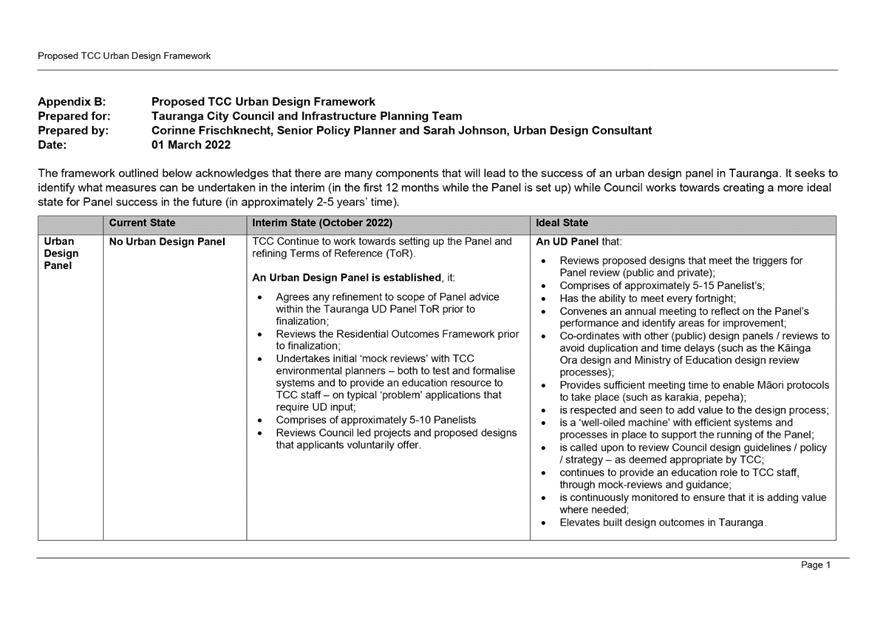
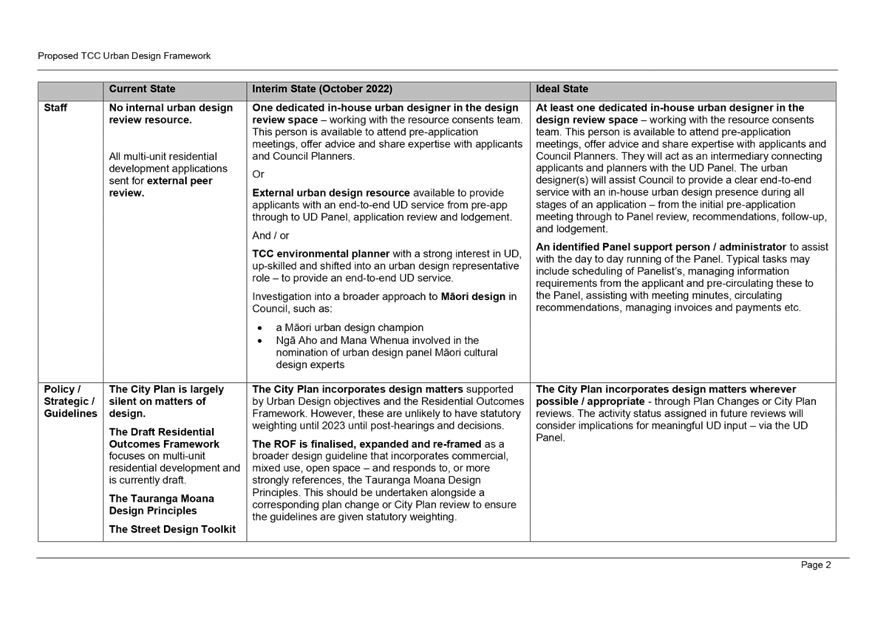
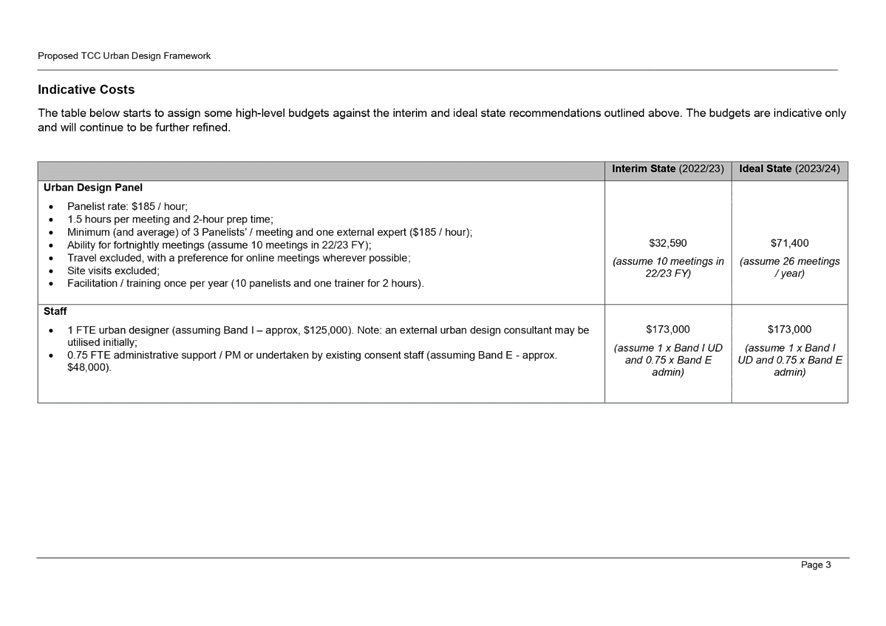
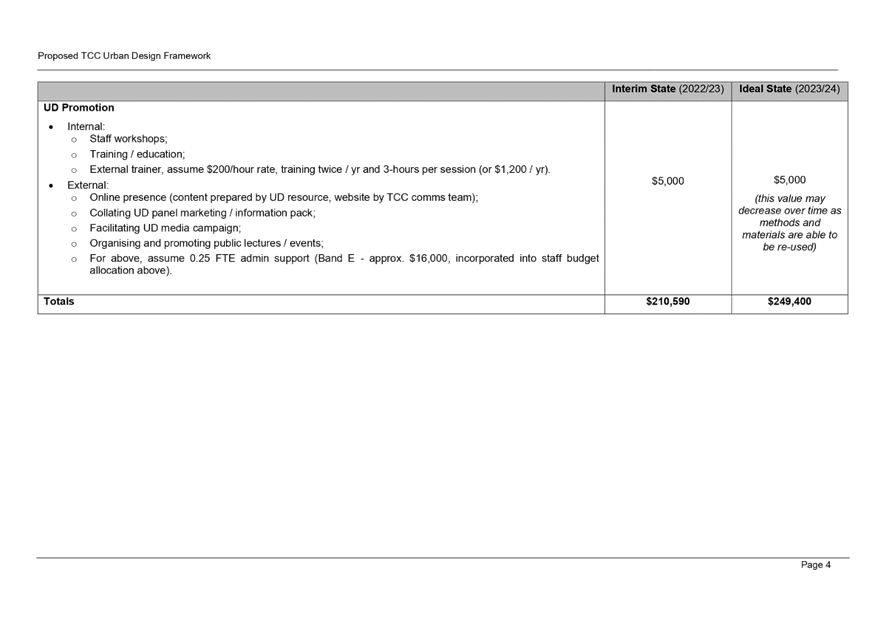
|
Strategy, Finance and Risk Committee
Meeting Agenda
|
28 March 2022
|

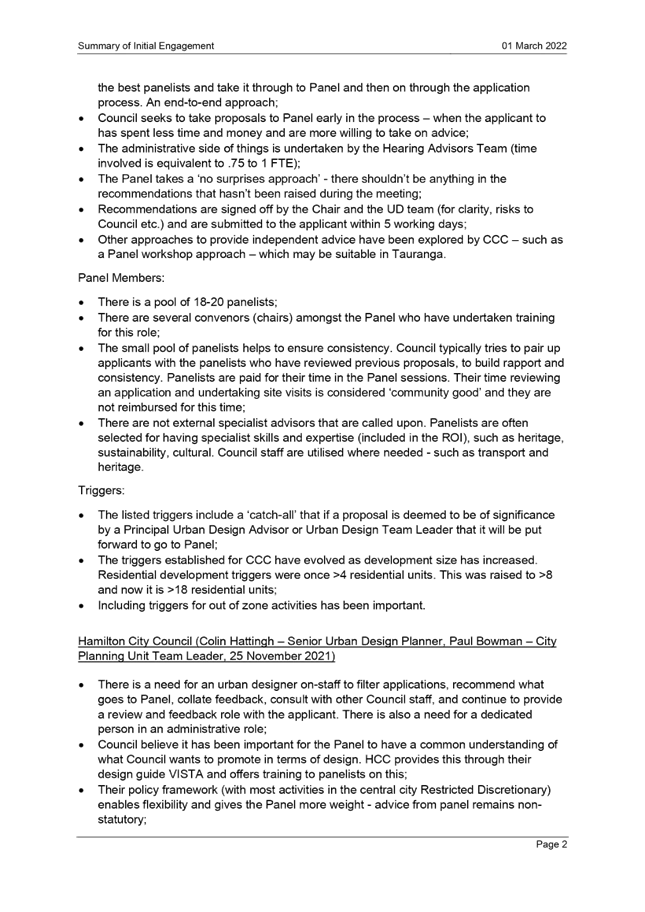


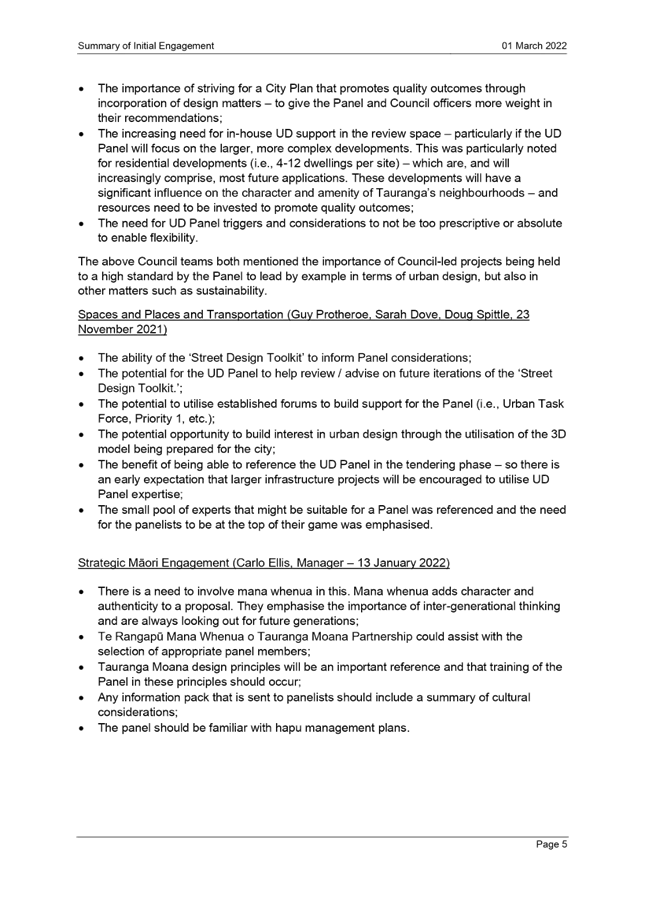


8.6 Plan
Change Work Programme for 2022
File
Number: A13194923
Author: Janine
Speedy, Team Leader: City Planning
Authoriser: Christine
Jones, General Manager: Strategy & Growth
Purpose
of the Report
1. The
purpose of this report is to seek direction on the high-level plan change work
programme for 2022 and implementation of the Resource Management (Enabling
Housing Supply and Other Matters) Amendment Act 2021.
|
Recommendations
That the Strategy,
Finance and Risk Committee:
(a) Approves
proceeding with a plan change to implement the Resource Management (Enabling
Housing Supply and Other Matters) Amendment Act by:
(i) Applying
the Medium Density Residential Standards to residential zones (currently
identified as Suburban Residential, Wairakei Residential, City Living and
High-Density Residential zones) with an appropriate rule framework; and
(ii) Giving
effect to Policy 3 in the National Policy Statement on Urban Development to
maximise heights in the City Centre Zone, enable at least 6 storeys within a
walkable catchment of the city centre and enable residential building height
and density appropriate to local, neighbourhood and town centres.
(b) Notes that greenfield urban
growth areas (Te Tumu and Tauriko West) and private plan changes will be
progressed through planning processes separate from (a) above.
(c) Notes that Plan Change 26
(Housing Choice) remains on hold to retain the opportunity to notify a
variation if subsequently identified as the most appropriate pathway.
|
Executive
Summary
2. There is a
significant work programme of plan changes to the Tauranga City Plan (City
Plan) underway in various stages of development or being progressed through the
formal plan change process.
3. Plan Change 26
(Housing Choice), Plan Change 27 (Flooding from Intense Rainfall) and Plan
Change 30 (Earthworks) were all notified in 2020, with Plan Change 27 and Plan
Change 30 being progressed through the hearing process to decisions.
4. On 15 November
2021, Council resolved to progress with priority plan changes in place of the
City Plan Review, and Plan Change 26 was placed on hold given impending changes
to legislation.
5. The
Resource Management (Enabling Housing Supply and Other Matters) Amendment Act
2021 (Amendment Act) was passed into law in December 2021, requiring Council to
progress a plan change with significant changes to residential zones. The
Amendment Act requires Council to implement the Intensification Planning
Instrument (IPI) to give effect to the intensification provisions of the
National Policy Statement on Urban Development (NPS-UD) and implement the
Medium Density Residential Standards (MDRS).
6. Greenfield
urban growth areas continue to work through the structure planning process and
preparation of plan changes for notification. This includes potential private
plan changes.
7. The plan change
work programme requires adequate resourcing and consideration of technical work
to ensure the Amendment Act and national policy direction requirements will be
met.
8. Given
the significant workload to progress this work programme, it is recommended
that no other new plan changes are initiated in 2022. It is proposed that the
priority plan change work programme is revisited in 2023 once the IPI has been
notified and the submission and further submission stages have been completed.
Background
9. On
15 November 2021, Council resolved to place the Tauranga City Plan Review on
hold and instead undertake a work programme of plan changes given the
uncertainties of the Resource Management Reforms. At this same meeting, it was
also resolved to place proposed Plan Change 26 on hold given the uncertainties
of the Resource Management (Enabling Housing Supply and Other Matters)
Amendment Bill announced on 19 October 2021.
10. On
20 December 2021 the Resource Management (Enabling Housing Supply and Other
Matters) Amendment Act 2021 (Amendment Act) was passed into law.
Extent of the work programme
11. Plan Change 26, Plan Change 27
and Plan Change 30 were notified in November 2020. Plan Change 27 proceeded to
a hearing at the end of November. At the time of writing this report, Council
were awaiting the Hearing Panel decision. For Plan Change 30, no submitters
wished to be heard, therefore the Hearing Panel considered all submissions
received and issued a decision. The decision was notified on 14 March 2022.
There is 30 working days for a submitter to make an appeal to the Environment
Court.
12. The Amendment Act has far
reaching implications that require Council to make amendments to large parts of
the City Plan through the IPI. The IPI must give effect to the intensification
provisions of the National Policy Statement on Urban Development (NPS-UD) and
implement the Medium Density Residential Standards. An overview of Policy 3 in
the NPS-UD and Medium Density Residential Standards are included in Attachment
1.
13. The MDRS sets out building
requirements to enable residential development that must be included in the
City Plan as a permitted activity. The MDRS building requirements include
providing three dwellings with a height limit of three storeys. There is
limited ability to include other rules and any rule that is included must
support or be consequential to the MDRS. The Amendment Act requires the MDRS to
be applied to residential zones. For the City Plan this includes:
(a) Suburban Residential Zone
(b) Wairakei Residential Zone
(c) City Living Zone
(d) High Density Residential Zone
14. The Amendment Act also requires
Council’s IPI to give effect to NPS-UD Policy 3:
(a) Maximise
building heights and density in the City Centre Zone to release as much housing
development capacity as possible; and
(b) Allow for
residential building heights of at least 6 storeys within a walkable catchment of
the City Centre Zone; and
(c) In and around
other commercial centres, allow for residential building heights and density
appropriate for the level of commercial activities and community services of
the centre.
15. The implementation of Policy 3
in the NPS-UD will be covered through a separate report to the May 2022
Strategy, Finance and Risk Committee meeting.
16. The Amendment Act does enable
Council to make the MDRS and NPS-UD heights and density less permissive where
there are certain features. These certain features are referred to as
qualifying matters. Qualifying matters include where there are matters of
national significance such as heritage, nationally significant infrastructure,
the New Zealand Coastal Policy Statement and open space provided for public
use.
17. There were large parts of the
City where Plan Change 26 provisions to enable greater housing choice were
unable to apply due to natural hazard policies within the Bay of Plenty
Regional Policy Statement. The Amendment Act includes a clause where objectives
and policies in a regional policy statement are inconsistent, they do not
apply. This requires Council to approach the consideration of natural hazards
differently. This is as a qualifying matter where the management of significant
risks from natural hazard is a matter of national importance in the RMA and the
New Zealand Coastal Policy Statement. Staff are currently working with Bay of
Plenty Regional Council on how this applies to Tauranga.
18. In giving effect to the
requirements of the Amendment Act, staff will be identifying what qualifying
matters may exist and will report back on a recommended approach to applying
qualifying matters. Any qualifying matter areas must be identified and robustly
evaluated as part of the section 32 evaluation process.
19. There
are parts of the rule framework and technical assessments prepared for Plan
Change 26 that remain relevant and will be implemented through the IPI. In
particular, implementation of the Te Papa Spatial Plan to provide additional
height within a walkable catchment of the city centre and Cameron Road and the
assessment criteria for residential developments that require a resource
consent.
20. It
is recommended that Plan Change 26 remains on hold to enable staff to prepare
the necessary technical work to implement the Amendment Act through the IPI.
This retains the opportunity to notify a variation to Plan Change 26 if this is
subsequently identified the most appropriate pathway.
21. There
are also the outcomes of the Ōtūmoetai Spatial Plan that will be
included to support Council giving effect to Policy 3 in the NPS-UD.
22. There
are limitations to what can be included in the IPI. The limitations include the
inability to make amendments to non-residential activities, provisions to
override covenants, additional rules that manage the same effects as the MDRS
such as height, building setbacks and outdoor living, and rules that restrict
servicing or infrastructure connections for one to three dwellings in existing
residential zones.
23. Staff
are currently considering other mechanisms for Council to consider
infrastructure capacity for one to three dwellings where there are capacity
constraints and an appropriate rule to consider infrastructure capacity for
four or more dwellings.
24. Once
the IPI is notified in August 2022, the MDRS providing for three dwellings on a
site and three storey height limit will have legal effect. Changes to the City
Plan that are consequential to or support the MDRS that give effect to Policy 3
in the NPS-UD (eg additional height and density in Te Papa) will have limited
weight until decisions are made and the Plan Change becomes operative.
25. Greenfield
urban growth areas continue to be progressed to be rezoned through a plan
change process, primarily providing for residential development. An update on
these plan changes and projects will be provided through the Growth and Land
Use Projects Report.
26. Consideration
was given to inclusion of greenfield areas, particularly Tauriko West and Te
Tumu, through the IPI. The IPI theoretically provides a planning pathway
for this, however we have been advised against this due to unclear and
incomplete drafting of the Amendment Act. Regardless, the timeframes for
the IPI to be notified in August 2022 require provisions to be drafted by June
2022. This is not possible for either Tauriko West or Te Tumu due to
unresolved issues in these process regarding freshwater / wetlands management,
long-term State Highway requirements (Tauriko West) and Tangata Whenua
engagement (Te Tumu).
27. There
is ongoing work to understand whether any other smaller scale greenfield areas
could be considered through the IPI eg Smiths Farm. Staff will report
back to Commissioners in the near future.
28. In
addition to Council initiated plan changes, developers and stakeholders are
able to initiate private plan changes, which Council can either accept and
process, adopt as its own plan change, or reject (provided good reasons exists
to do so). There are two private plan changes currently being prepared to lodge
with Council in 2022:
a) Tauriko Business Estate (Stage 4) extension –
Rezoning Rural to Industrial. Not affected by the Amendment Act.
b) Upper Ohauiti – Rezoning Rural to Residential.
Must include the Amendment Act requirements to implement the MDRS.
Timing and pathway of plan changes
29. The
Amendment Act requires Council to notify the IPI by 20 August 2022.
30. The
Amendment Act created a new streamlined process for councils to implement the
IPI, the Intensification Streamlined Planning Process (ISPP). The IPI must be
heard by an independent panel who makes recommendations to the council. If
council agrees with the recommendations it notifies the decision. If council
disagrees with the independent panel’s recommendations, the Minister for
the Environment makes the final decision. The ISPP does not allow appeals to
the Environment Court.
31. The
timeframe that Council will follow for each step of the ISPP will be set by the
Minister for the Environment.
32. The
following work programme will utilise the full capacity of TCC’s planning
team.
(a) Existing Plan Changes (PC 27
& 30)
(b) New plan change to implement
the IPI
(c) TCC led greenfield plan
changes (eg Tauriko West and Te Tumu)
(d) Private plan changes (Tauriko
Business Estate & Upper Ohauiti)
As
such, it is recommended that no other new plan changes are initiated in 2022.
It is proposed that the priority plan change work programme is revisited in
early 2023 once the IPI has been notified and the submission and further
submission stages have been completed.
Strategic / Statutory
Context
33. The
provision of a sufficient supply and variety of residential development
capacity to meet market demand over time is a key part of the overall city
growth objectives and addressing current shortages. The work programme for 2022
is focussed on increasing capacity for residential development within our
existing residential zones, by implementing the MDRS and increasing building
height and density around centres and within our greenfield urban growth areas by
rezoning primarily for residential. This is consistent with the UFTI
overall guiding connected centres urban form.
Financial Considerations
34. There
are no financial considerations associated with this report. The cost
associated with the work programme will be met within existing budgets.
Legal Implications /
Risks
35. All
plan changes will be prepared to meet the legislative requirements under
Schedule 1 of the Resource Management Act 1991.
36. The
Amendment Act sets out what must be included, can be included and cannot be
included within the IPI. This constrains the scope of the IPI, which has been
set out in Attachment 1. The IPI must be notified by 20 August 2022.
37. Each
plan change process has a risk register that is revisited on a regular basis.
The key risks identified across the work programme are:
(a) Plan change scope increasing
and resourcing being insufficient;
(b) The ability to give effect to
national policy statements;
(c) Tight timeframes to deliver a
plan change to meet the Amendment Act requirements;
(d) Meeting community, tangata
whenua and stakeholder expectations.
Consultation /
Engagement
38. Communications
and engagement plans are prepared for tangata whenua, key stakeholders and the
wider community for all plan changes.
39. In
regard to the implementation of the Amendment Act, there is a requirement that
Council undertake pre-consultation that meets the requirements of Schedule 1 of
the RMA.
40. The timeframes leading to notification and the volume of
work that needs to be undertaken before 20 August 2022, means that the approach
to engagement will be heavily focussed on informing stakeholders and the
community about the proposed changes, and for most, directing them to the
notified plan change as the best opportunity to provide feedback through the
submission process. However, feedback will be sought prior to notification from
some stakeholders that have a higher degree of interest in the proposed changes
and with tangata whenua.
41. The Amendment Act is also very directive in that there are
some changes that are required to be made to the City Plan that have limited
opportunity for feedback to influence outcomes such as the MDRS.
42. There
was comprehensive engagement through 2019 and 2020 on the Te Papa Spatial Plan
and Plan Change 26. This feedback and submissions on Plan Change 26 will be considered
in the preparation of the IPI. The Ōtūmoetai Spatial Plan project is
also underway with engagement to be undertaken mid-year.
43. Policy
3(d) in the NPS-UD requires Council to enable greater intensification around
centres. Due to the tight timeframes to progress this work for public
notification, spatial planning of some areas will be undertaken in the future
eg in the Mount Maunganui. This spatial planning will identify other projects
and funding required to support growth and intensification, such as community amenities.
These spatial planning projects will include community engagement similar to
that undertaken through the Te Papa and Ōtūmoetai Spatial Plans.
44. Consultation
continues with tier 1 councils, legal advisors and central Government agencies
on the implementation of the Amendment Act.
Significance
45. The
Local Government Act 2002 requires an assessment of the significance of
matters, issues, proposals and decisions in this report against Council’s
Significance and Engagement Policy. Council acknowledges that in some
instances a matter, issue, proposal or decision may have a high degree of
importance to individuals, groups, or agencies affected by the report.
46. In
making this assessment, consideration has been given to the likely impact, and
likely consequences for:
(a) the current
and future social, economic, environmental, or cultural well-being of the
district or region
(b) any persons who are likely to be
particularly affected by, or interested in, the decision.
(c) the capacity of the local authority to
perform its role, and the financial and other costs of doing so.
47. In
accordance with the considerations above, criteria and thresholds in the
policy, it is considered that the decision is of high significance.
ENGAGEMENT
48. Taking
into consideration the above assessment, that the decision is of high significance,
staff are of the opinion that the consultation will be undertaken as set out in
the engagement section of this report and to meet the requirements under the
RMA.
Next Steps
49. Proceed
with the preparation of a plan change to implement the Amendment Act. Report
back to the Strategy, Finance and Risk Committee in May to seek further
direction on the implementation of Policy 3 in the NPS-UD.
Attachments
1. Attachment
1 - Requirements of the Resource Management (Enabling Housing Supply and Other
Matters) Amendment Act 2021 - Strategy, Finance and Risk Committee - 28 March
2022 - A13270224 ⇩ 
|
Strategy, Finance and Risk
Committee Meeting Agenda
|
28 March 2022
|


8.7 Adoption
of draft Waste Management and Minimisation Bylaw 2022 for consultation
File
Number: A13224333
Author: Cole
Burmester, Waste Planning Manager
Sam Fellows, Manager:
Sustainability and Waste
Jane Barnett, Policy Analyst
Authoriser: Nic
Johansson, General Manager: Infrastructure
Purpose of the Report
1. To
consider the approval of the draft Waste Management and Minimisation Bylaw 2022
for consultation and to adopt the Statement of Proposal.
|
Recommendations
That the Strategy,
Finance and Risk Committee:
(a) Approve
the draft Waste Management and Minimisation Bylaw 2022 (Attachment A)
for community consultation.
(b) Adopt
the Statement of Proposal for the draft Waste Management and Minimisation
Bylaw 2022 (Attachment B) for community consultation.
(c) Resolve
that in accordance with section 155 of the Local Government Act 2002, the
proposed draft Waste Management and Minimisation Bylaw 2022, is the most
appropriate and proportionate way of addressing the perceived problem and
does not give rise to any implications under the New Zealand Bill of Rights
Act 1990.
(d) Delegate
to staff the ability to make any minor edits or amendments to the draft Waste
Management and Minimisation Bylaw 2022 or Statement of Proposal to correct
any identified errors or typographical edits.
|
Executive Summary
2. Tauranga
City Councils Waste Management and Minimisation Bylaw (‘the Waste
Bylaw’) was adopted on 1 July 2012. It sets out the guidelines for the
collection and management waste and recyclables.
3. Under
section 58 of the Waste Minimisation Act (‘WMA’), the Bylaw must be
reviewed no later than 10 years after the bylaw was made. This review has begun
and been undertaken in accordance with the requirements set out in the WMA.
4. Pre-engagement
has been carried out with stakeholders to gather feedback – including
three workshops held in late-February with waste operators, waste industry
experts and interested parties, and members of the construction and demolition
industry.
5. To
respond to the current waste management problems and the revised draft Waste
Management and Minimisation Plan (WMMP), a number of changes have been proposed
to the Bylaw.
6. The
Committee are asked to approve the proposed draft Waste Bylaw for consultation
using the special consultative procedure, as set out in the Local Government
Act 2002.
7. If
the Committee decides to approve the draft Waste Bylaw and adopt the Statement
of Proposal consultation will be carried out between 29 April – 30 May
2022.
Background
8. The
current Waste Bylaw includes regulation on cleanfill, events, kerbside
collections, and operator licensing. It was drafted to satisfy the vision,
goals, and targets of Council’s two previous WMMPs adopted in 2010 and
2016, respectively.
9. Since
the current Waste Bylaw was adopted, a number of discrete but important waste
management problems have emerged:
(a) The
way we currently consume products leads to large quantities of waste.
(b) There
is a high volume of household waste going to landfill that could be diverted.
(c) The
proportion of our community living in multi-unit dwellings is growing.
(d) Litter
and illegal dumping, which has environmental and financial costs, is
increasing.
(e) Businesses
and organisations need better services to divert waste from landfill.
(f) There
is a high volume of construction and demolition material going to landfill.
(g) Disposing
of biosolids to landfill has significant cultural, environmental, social, and
economic effects.
(h) Cost
and volume uncertainty has risen due to legislation change or service
interruption.
(i) Unforeseen
events can result in high volumes of waste in a short period.
10. In
addition to the identified issues above, we recognise that there are two
additional issues that touch all of the issues raised above and therefore, are
not standalone issues in themselves. These are:
(a) That
the generation, management, and minimisation activities from waste are fluid.
It is often generated in one district, then transferred and/or consolidated in
another district, before being disposed somewhere else. Waste is also often
transferred through districts.
(b) Lack
of recognition of Te Tiriti o Waitangi (Te Tiriti) and te ao Māori. The
2016 WMMP did not contain any reference to Te Tiriti o Waitangi or te ao
Māori. These are notable gaps in modern environmental legislation for
Aotearoa, which has been recognised in the Governments proposed Waste Strategy
and Legislation.
11. A
draft WMMP for 2022-2028 has been prepared to address these changes. This includes
an updated vision, goals, objectives, and targets, which the Waste Bylaw must
not be inconsistent with.
12. Furthermore,
Council recently procured kerbside collection services for refuse, mixed
recycling, glass, food waste, and garden waste and the associated
consolidation, processing and disposal services. The new service contracts
commenced in July 2021. This is the first time in 20 years that Council is
providing a comprehensive suite of kerbside collection services (adding to the
existing glass collection established in 2018). This significant change for the
city is intended to reverse a legacy of declining waste diversion.
13. In
reviewing the bylaw, a number of changes have been proposed to address the
issues identified above and to ensure alignment with the revised WMMP.
14. Table
One below summarises the proposed changes. These changes will ensure the bylaw
is relevant, future proofed, consistent with the WMMP, and will help Tauranga
achieve its waste reduction targets.
Table One: Key Proposed Changes
to the Waste Bylaw
|
Proposed Change
|
Reason
|
|
Provision for Council to make, amend or revoke regulations
for waste management and minimisation via specific control provisions
|
Allows greater flexibility and faster response times to
changing conditions
|
|
Amend waste operator licensing provisions
|
Improved data collection and alignment with new
legislative requirements
|
|
Requirement for building consent applications over a set
value to submit a site waste management plan
|
Ensures waste from large scale construction and demolition
work is managed and minimised
|
|
Requirement for multi-unit developments to provide site
waste management plans demonstrating services, bin storage, and access
|
Ensures appropriate planning and provision for waste in
multi-unit developments
|
|
Revise the regulations for waste management at events to
include a prescribed set of requirements
|
To encourage better planning and management of waste at
events
|
|
Include and update provisions for Council to cover illegal
dumping and litter, including unaddressed mail and inorganic collections
|
To reduce nuisance and make the overall bylaw
comprehensive, covering all areas where it is useful to have regulatory tools
to assist with managing local waste related activity and enforcement for non-compliance
|
15. When
making or reviewing bylaws, Council is required under section 155(1) of the
Local Government Act 2002 to consider if a bylaw is the most appropriate way of
addressing the perceived problem. If it is, section 155(2) requires Council to
determine whether the proposed draft bylaw is the most appropriate form of
bylaw and whether it gives rise to any implications under the New Zealand Bill
of Rights Act 1990.
16. Table
Two below summarises this section 155 analysis from the Waste Management and
Minimisation Bylaw Determination Report (Attachment C). It identifies
the perceived problems and considers the provisions in the draft Waste Bylaw
that aim to address them.
Table Two: Section 155 Analysis
|
Perceived Problem
|
Is a bylaw the most
appropriate way of addressing the perceived problem?
|
Is the Draft Waste Bylaw the
most appropriate form of bylaw?
|
Any NZ Bill of Rights 1990
implications?
|
|
There is a high volume of
household waste going to landfill that could be diverted.
|
Council should continue to rely on education and behaviour
change campaigns and programmes as the primary mechanisms to increase
diversion, particularly as delivered through their new collection services.
However, the introduction of a bylaw that allows Council to specify approved
materials, use of receptables, specifics of collection services and
enforcement measures is a useful backstop measure to reduce contamination
levels. It provides Council with enforcement tools if a user of the servicer
intentionally and persistently misuses the service.
|
The draft clauses place obligations on occupiers and
persons putting out waste (including recyclables) on the kerbside for
collection to address the perceived problems. These requirements are
reasonable and do not place onerous obligations on occupiers.
|
No
|
|
The proportion of our
community living in multi-unit dwellings is growing.
Compact living within MUDs (which is 6+ dwellings) results in a number of waste issues, including what
services are required, as well as storage and access to these.
|
Whilst the Building Code (Clause G15 Solid Waste)
stipulates that “buildings shall be provided with space and facilities
for the collection, and safe hygienic holding prior to disposal, of solid
waste arising from the intended use of the buildings”, this clause does
not apply to MUDs if there is an independent access, or if there is a private
open space at the ground level.
This clause does not specify the minimum area for waste
and recycling storage.
An alternative solution is to introduce new City Plan
provisions, such as was done through Plan Change 26. Which looked to include
minimum size storage areas for waste.
However, Council cannot retrospectively apply Building
Code or City Plan provisions to existing buildings. But the Council can
regulate waste and recycling service collection requirements to both new and
existing multi-unit developments through a Bylaw.
For this reason, the Building Code and City Plan
provisions are considered inadequate both for accommodating the waste
management needs of residents in both new and existing buildings.
Therefore, Council should continue to rely on education
and behaviour change campaigns and programmes as the primary mechanisms to
manage the volume of waste and reduce waste going to landfill. As well as
introduce a bylaw that allows Council to require site waste management and
minimisation plans specific to each MUD is a useful backstop measure to
ensure the level of service for each MUD is appropriate, particularly prior
to new MUDs being constructed. It also provides details on what the
responsibilities will be for owners/occupiers.
|
The draft clauses place obligations on developers and
designers of new MUDs to consider access and storage as part of waste
management, which is linked to approval/consent for development of the MUD.
This also shares the responsibilities of waste management
for owners/occupiers to ensure that waste is disposed of in the right
receptacles.
|
No
|
|
There is a high volume of construction
and demolition material going to landfill.
|
The key issues include, but are not limited to,
constrained capacity to process and recover construction and demolition
waste, the availability of low cost disposal close to where many major
projects are occurring, and a lack of incentives that would encourage or
promote waste minimisation.
Council is addressing the issue of capacity to process and
recover this waste by upgrading the Te Maunga Transfer Station.
To address the other aspects, Council could continue to
rely on voluntary waste minimisation practices to promote waste minimisation.
But as this is the current situation, it obviously is not working at a large
scale.
A bylaw requiring site waste management plans for
construction and demolition projects over a certain dollar value will better
promote diversion and enable a better understanding of the construction and
demolition waste stream through enhanced reporting requirements under the
bylaw when compared to voluntary practices.
Council highlights that any new bylaw provision that
allows Council to set a control requiring site waste management plans will
not come into force immediately as Council first needs the new Te Maunga
construction and demolition facility to be operating. Council also needs time
to deliver training and behaviour change programmes alongside the rollout of
such provisions. As part of that work Council will also consider what the
most appropriate value would be of a building project on the coast to trigger
the requirement of providing a site waste management plan.
Council may also introduce specific Bylaw controls in the
future that provide the ability to determine the types and categories of
acceptable and prohibited waste that is able to be deposited at a waste
management facility.
Council will also use mechanisms of influence, monitoring,
and education and behaviour change programmes to increase waste diversion.
|
The draft clauses place obligations on the construction
and demolition industry to provide site waste management plans that identify
the type and volume of waste that is likely to be generated from their
projects. The management and minimisation of this waste will need to be
assessed and then the site waste management plan adhered to, to maximise
diversion from landfill.
|
No
|
|
Cost and volume uncertainty
has risen due to legislation change or service interruption.
|
Council will largely rely on
working with local and central government to influence national policy
settings on waste and resource recovery. This will allow Council to keep
abreast of regulatory change.
Council is including a suite
of enabling provisions that will provide the ability to set controls for the
types and categories of acceptable and prohibited waste and recyclables.
|
The draft clauses allow
Council to be able to set controls for the management of specific types and
quantities of waste under the current circumstances, while still having the
flexibility to adopt new changes that are consistent with National policy and
legislation without have to change any aspect of the bylaw in the future.
|
No
|
|
Strategy, Finance and Risk
Committee Meeting Agenda
|
28 March 2022
|
17. Overall, a
bylaw is an effective regulatory tool to minimise negative impacts of waste on
the environment and protect the health and safety of the community and those
involved in waste management. While non-regulatory measures (education,
guidelines and information) and operational practices can help address these
issues, a bylaw is required for the reasons above.
18. Without
the bylaw the environment would be at greater risk to damage, waste could
create a nuisance, and the community would also be more vulnerable to health
and safety risk.
19. The
proposed draft bylaw addresses the issues of waste management by addressing a
number of unwanted outcomes. It also provides flexibility and allows for
changing conditions by enabling Council to change waste regulations if
required.
20. The
proposed draft bylaw is clear on what activities are permitted, controlled,
restricted, and prohibited, and sets out what action is required for compliance.
The proposed draft is consistent with the vision, objectives, targets, and
actions of the draft WMMP 2022-2028.
21. Therefore,
the draft Waste Management and Minimisation Bylaw 2022 (Attachment A) as
drafted is the most appropriate way of addressing the problems.
22. The
proposed draft bylaw is the most appropriate form of bylaw and does not raise
any implications under the New Zealand Bill of Rights Act 1990.
Strategic
/ Statutory Context
23. The
amendments achieve the vision and strategic waste priorities and help to
promote effective and efficient waste minimisation within our city.
Options
Analysis
24. Option
1: Approve the draft Waste Bylaw 2022 for consultation and adopt the Statement
of Proposal. (Recommended)
|
Advantages
|
Disadvantages
|
|
· Provides
opportunity for wider community to give feedback on the draft Waste Bylaw.
· Allows Council
to continue to support the management and minimisation of waste.
· Meet Councils
obligations, in relation to waste, to protect the public from nuisance, to
protect, promote and maintain public health and safety, and to minimise the
potential for offensive behaviour in public places.
· Ensures legal
requirements of reviewing the bylaw are met
|
· None
|
|
Budget - Capex
|
None
|
|
Budget - Opex
|
Within current resources
|
|
Key risks
|
None
|
|
Recommended?
|
Yes
|
25. Option
2: Do not approve draft Waste Bylaw or adopt Statement of Proposal for
consultation
|
Advantages
|
Disadvantages
|
|
· None.
|
· The draft Waste
Bylaw could be approved at a later stage if more analysis and/or research is
required to be undertaken prior to approving a draft for consultation.
· However, it
should be noted the Waste Bylaw must be adopted by 1 July 2022 to meet statutory
timeframes under the WMA.
|
|
Budget - Capex
|
None
|
|
Budget - Opex
|
None
|
|
Key risks
|
None
|
|
Recommended?
|
No
|
Financial
Considerations
26. No unexpected costs as the
associated costs to implement the draft Waste Bylaw can be accommodated within existing
budgets.
Legal
Implications / Risks
27. The
Waste Bylaw must be reviewed and a new one adopted by 1 July 2022 to meet
statutory timeframes under the WMA.
Consultation
/ Engagement
28. Consultation
with the community is a key focus to ensure that what we are proposing is
supported by the community. In particular, the introduction of controls for
future regulations around the construction and demolition industry and for
multi-unit developments.
29. This
is why we have undertaken pre-engagement with stakeholders – including
three workshops held in late-February with waste operators, waste industry
experts and interested parties, and members of the construction and demolition
industry to gather feedback.
30. Additional
consultation is planned after the Waste Bylaw is implemented and the new
controls are developed. This will allow for the development of the site waste
plan templates, and training and behaviour change programmes for the industry.
Significance
31. The Local Government Act 2002 requires
an assessment of the significance of matters, issues, proposals, and decisions
in this report against Council’s Significance and Engagement
Policy. Council acknowledges that in some instances a matter, issue,
proposal, or decision may have a high degree of importance to individuals,
groups, or agencies affected by the report.
32. In making this assessment,
consideration has been given to the likely impact, and likely consequences for:
(a) the current
and future social, economic, environmental, or cultural well-being of the
district or region
(b) any persons who are likely to be
particularly affected by, or interested in, the decision.
(c) the capacity of the local authority to
perform its role, and the financial and other costs of doing so.
33. In accordance with the
considerations above, criteria and thresholds in the policy, it is considered
that the decision is of high significance.
ENGAGEMENT
34. Taking into consideration the
above assessment, that the decision is of high significance, and the requirement
of the Local Government Act 2002 consultation using the special consultative
procedure will be undertaken.
Next
Steps
35. Following
is a timeline to introduce and adopt the Waste Management and Minimisation Plan
2022-2028 and Waste Bylaw 2022.
|
Committee meeting
|
28 March 2022
|
Seeking adoption of the draft
Waste Bylaw for public consultation
|
|
Public consultation
|
29 April – 30 May 2022
|
Public consultation on the draft
Waste Bylaw
|
|
Hearings
|
13 June 2022
|
Public hearings, if required, for
draft Waste Bylaw
|
|
Deliberations
|
20 June 2022
|
Finalise and adopt the Waste Bylaw
following public consultation and hearings
|
Attachments
1. Draft
Waste Management and Minimisation Bylaw 2022 - A13222915 ⇩ 
2. Statement
of Proposal for draft Waste Management and Minimisation Bylaw 2022 - A13222666 ⇩ 
3. Waste Management
and Minimisation Bylaw Determination Report - A13291153 ⇩ 
|
Strategy, Finance and Risk Committee
Meeting Agenda
|
28 March 2022
|


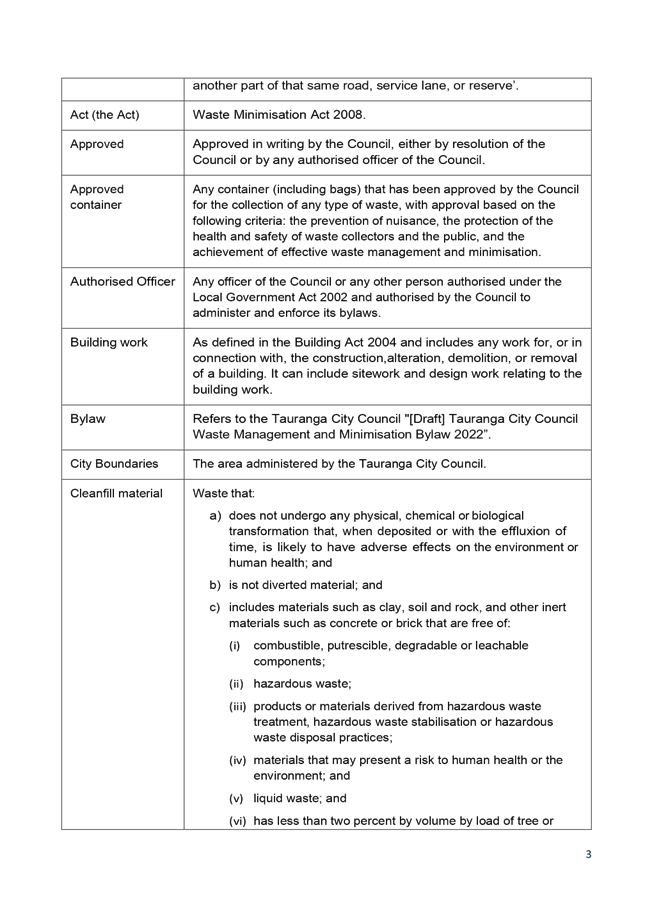




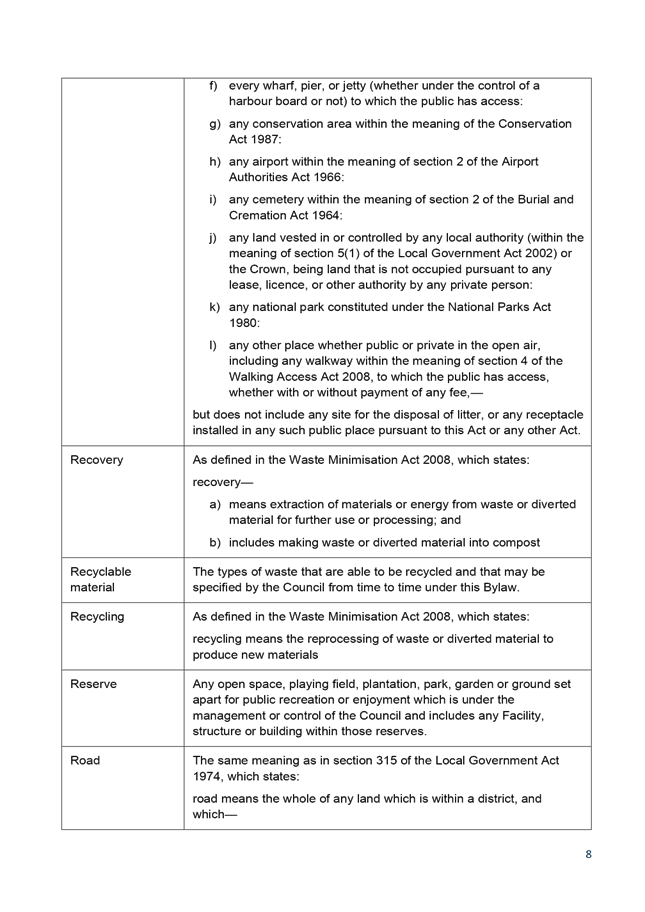
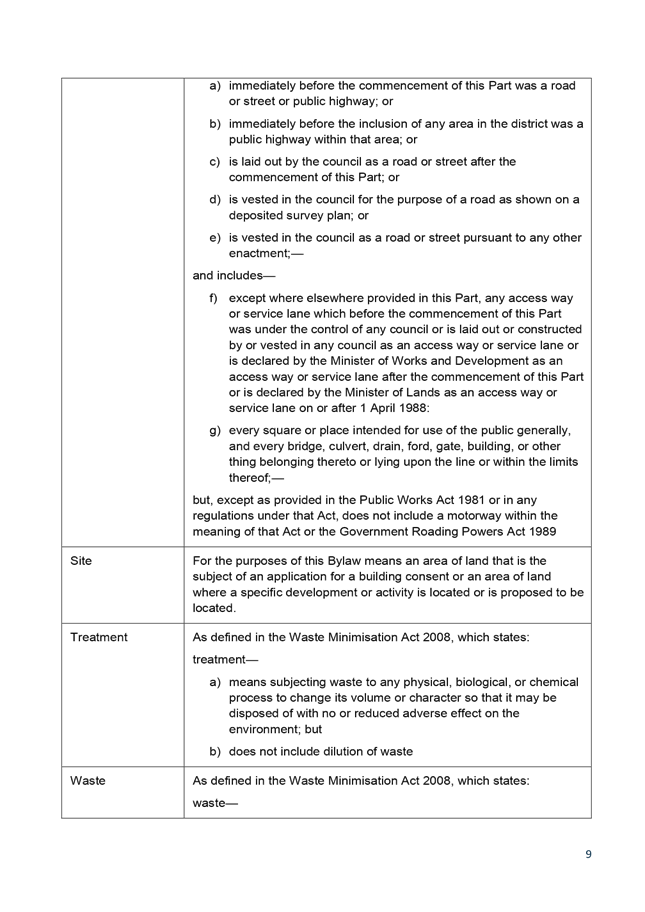








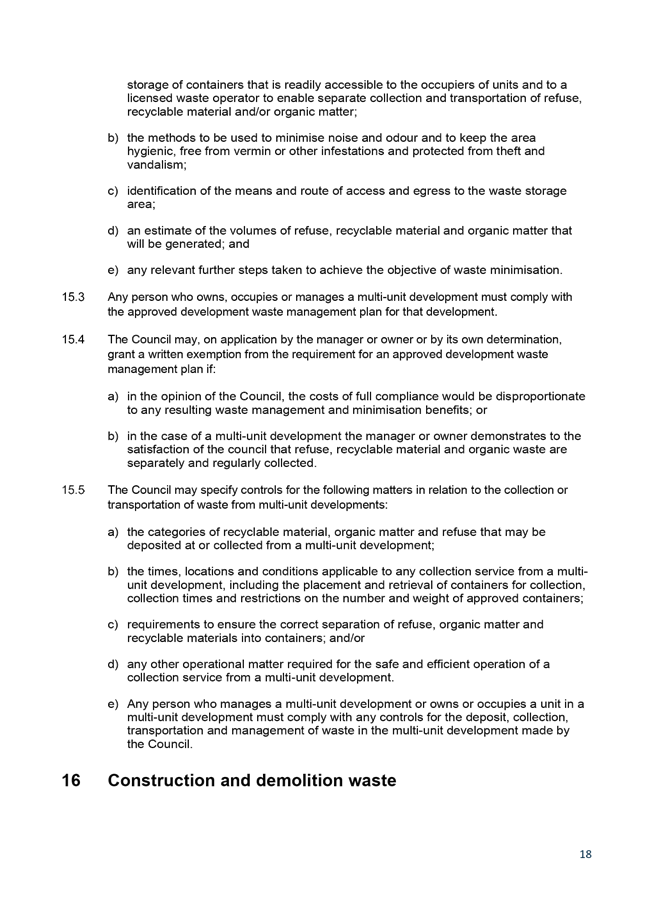
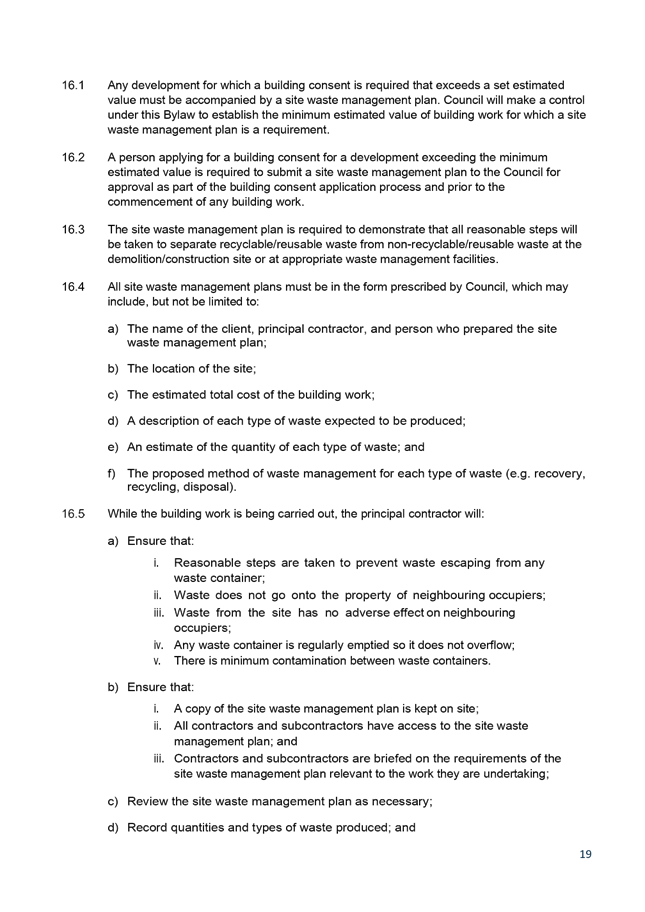




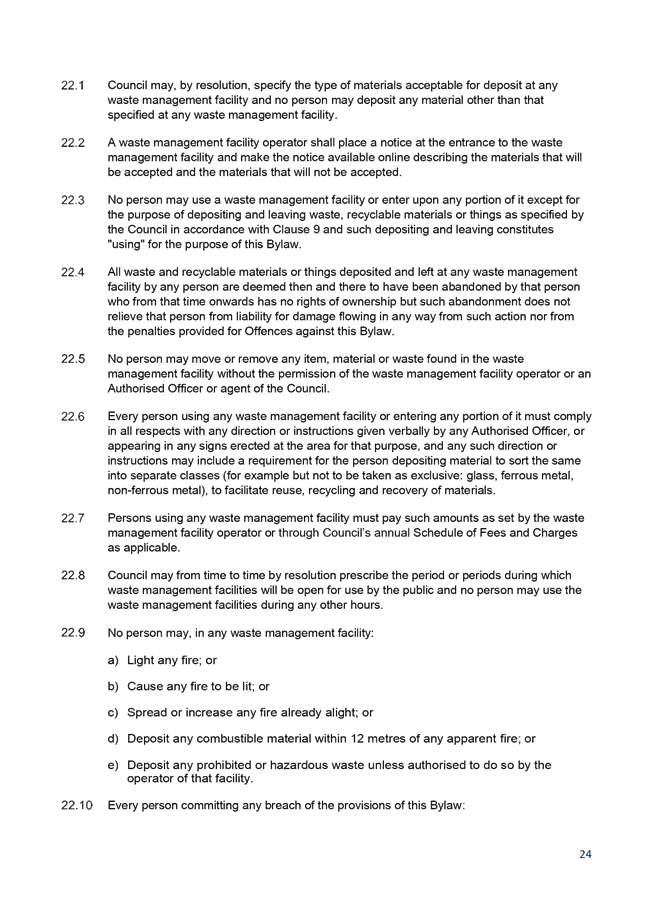


|
Strategy, Finance and Risk Committee
Meeting Agenda
|
28 March 2022
|
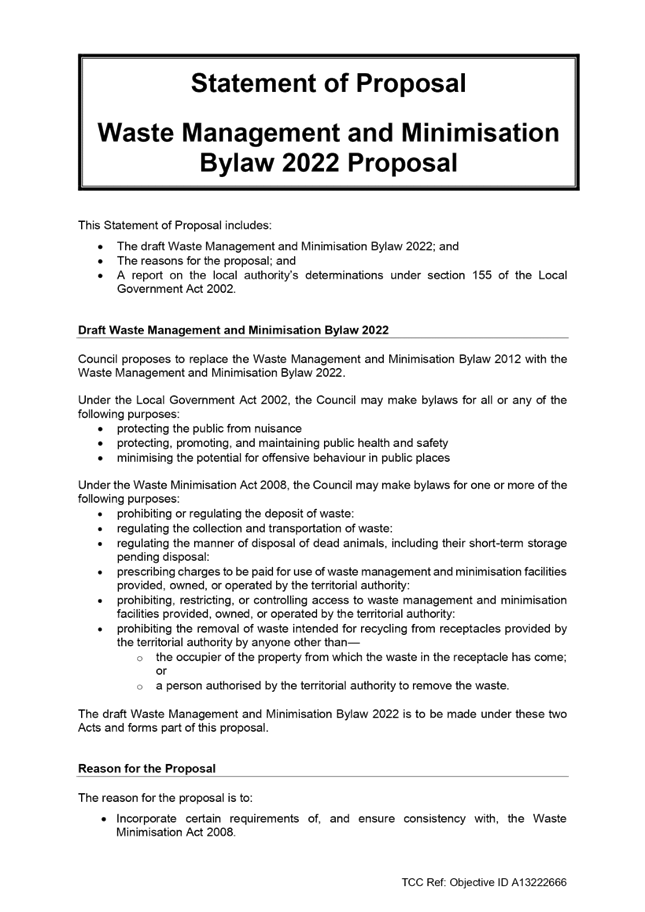
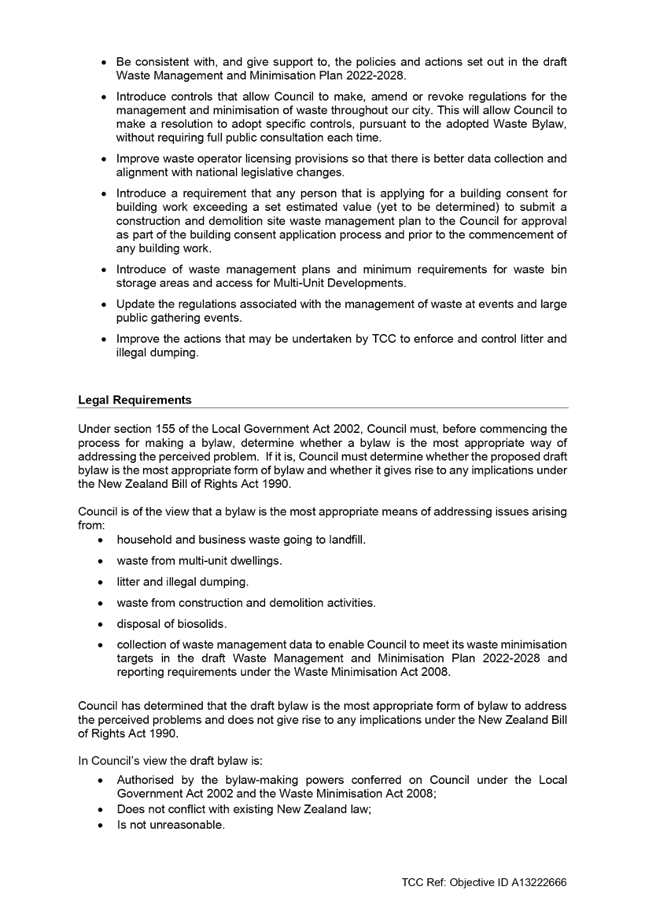
|
Strategy, Finance and Risk Committee
Meeting Agenda
|
28 March 2022
|
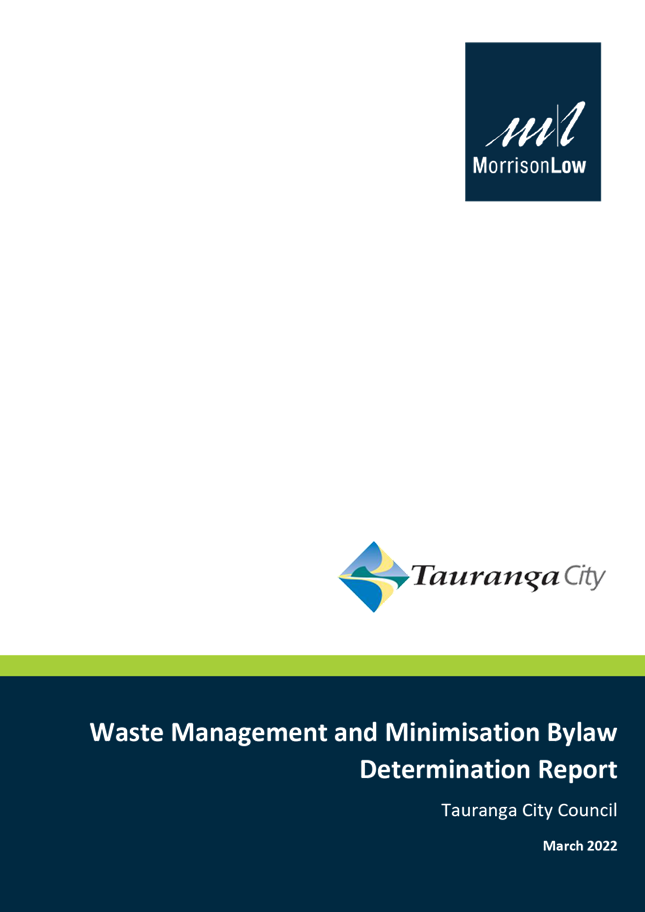


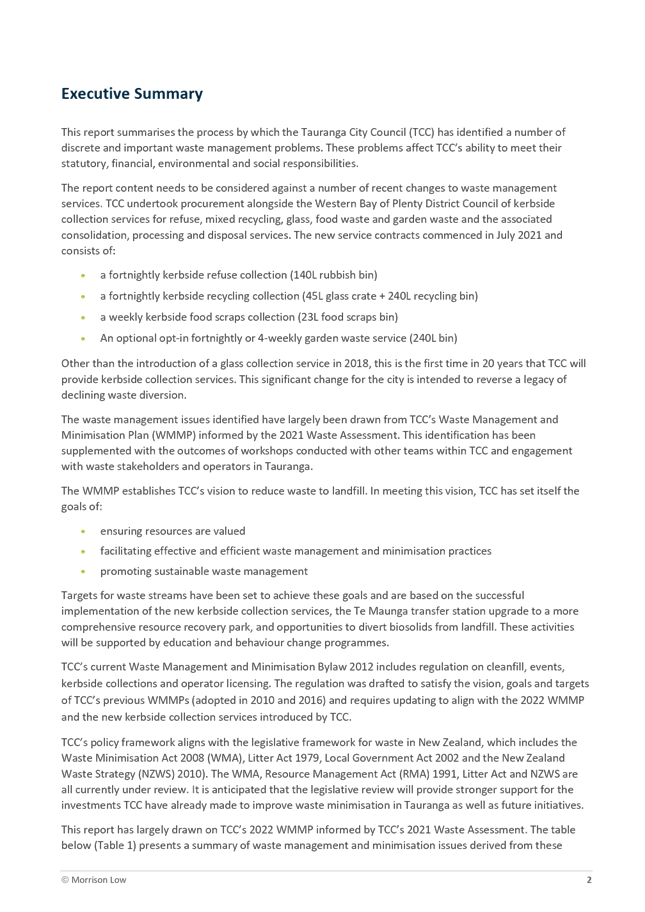



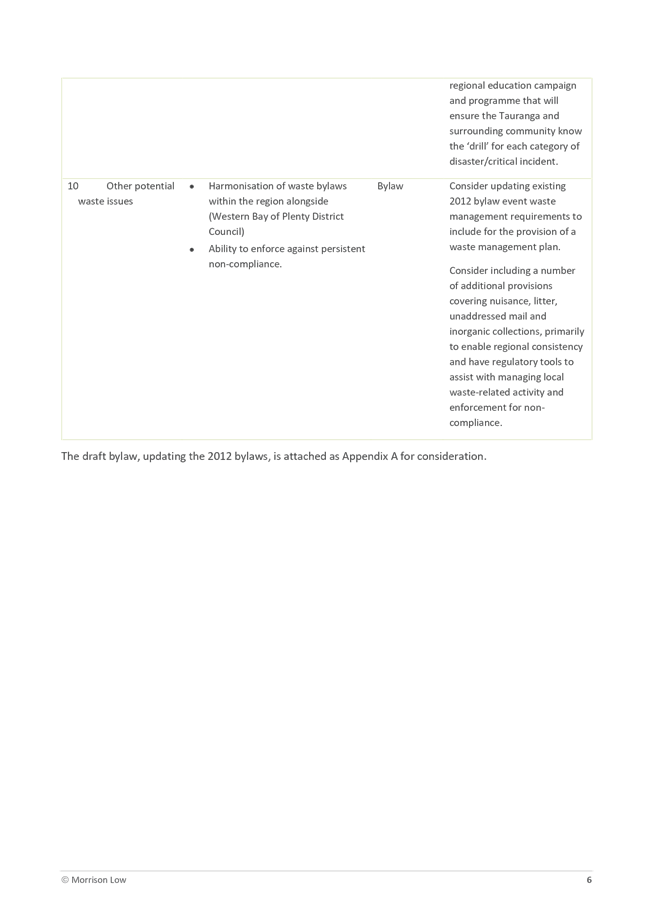













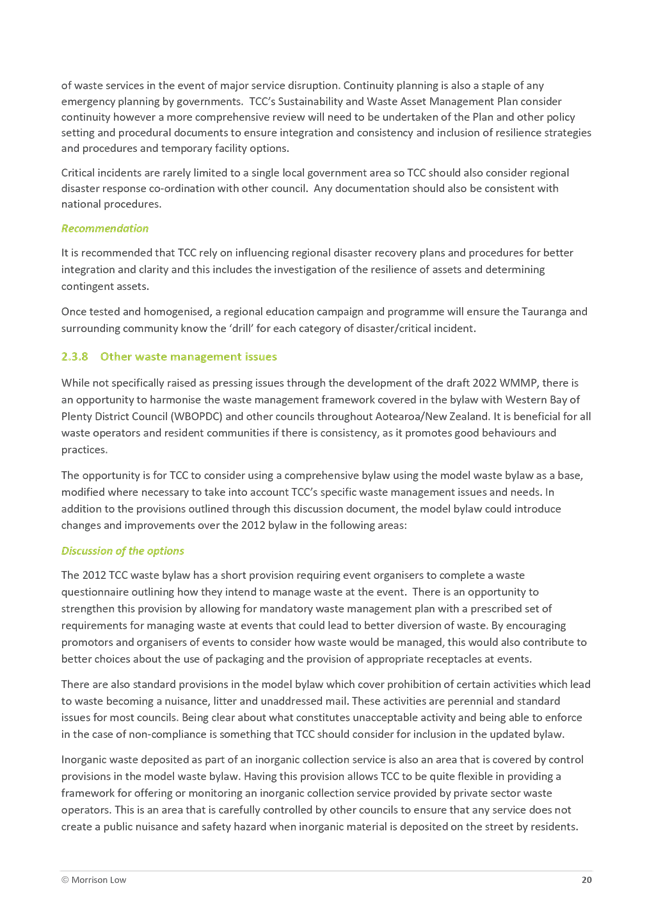


8.8 Adoption
of draft Waste Management and Minimisation Plan 2022-2028 for consultation
File
Number: A13224529
Author: Cole
Burmester, Waste Planning Manager
Sam Fellows, Manager:
Sustainability and Waste
Authoriser: Nic
Johansson, General Manager: Infrastructure
Purpose of the Report
1. To consider the
approval of the draft Waste Management and Minimisation Plan 2022-2028 for
consultation.
|
Recommendations
That the Strategy,
Finance and Risk Committee:
(a) Approve
the draft Waste Management and Minimisation Plan 2022-2028 (Attachment A)
for community consultation.
(b) Delegate
to staff the ability to make any minor edits or amendments to the draft Waste
Management and Minimisation Plan 2022-2028 or Statement of Proposal to
correct any identified errors or typographical edits.
|
Executive Summary
2. Tauranga
City Council (TCC) must promote effective and efficient waste management and
minimisation within our city[1].
We do this by providing waste services and facilities, funding innovative waste
reduction initiatives, and educating our community to enable behaviour changes.
3. To
support this work, TCC must review and adopt a Waste Management and
Minimisation Plan (WMMP) every six years, a requirement of the Waste
Minimisation Act 2008. The WMMP sets the vision, goals, objectives, targets,
and action plan for achieving efficient and effective waste management and
minimisation. It also provides information on how TCC intends to fund the
activities of the WMMP.
4. The
current WMMP was adopted in August 2016 as the second WMMP prepared by TCC,
with the first being a joint WMMP with the Western Bay of Plenty District
Council that was adopted in 2010.
5. The
current WMMP focused on further investigation and consideration of solutions
for kerbside services. This resulted in the successful rollout of the
rates-funded kerbside service on the 1st July 2021. In addition, the
WMMP proposed to continue enhancing the services at the transfer stations,
deliver the behaviour change programme, and collaborate with the private and
public sector to improve the reduction, reuse, and recycling of waste and to
improve the quality of data we have available to us to make good decisions.
6. Since
the current WMMP was adopted, a number of discrete but important waste
management problems have emerged for TCC:
(a) The
way we currently consume products leads to large quantities of waste.
(b) There
is a high volume of household waste going to landfill that could be diverted.
(c) The
proportion of our community living in multi-unit dwellings is growing.
(d) Litter
and illegal dumping, which has environmental and financial costs, is
increasing.
(e) Businesses
and organisations need better services to divert waste from landfill.
(f) There
is a high volume of construction and demolition material going to landfill.
(g) Disposing
of biosolids to landfill has significant cultural, environmental, social, and
economic effects.
(h) Cost
and volume uncertainty has risen due to legislation change or service
interruption.
(i) Unforeseen
events can result in high volumes of waste in a short period.
7. In
addition to the identified issues above, we recognise that there are two
additional issues that touch all of the issues raised above and therefore, are
not standalone issues in themselves. These are:
(a) That
the generation, management, and minimisation activities from waste are fluid.
It is often generated in one district, then transferred and/or consolidated in
another district, before being disposed somewhere else. Waste is also often
transferred through districts.
(b) Lack
of recognition of Te Tiriti o Waitangi (Te Tiriti) and te ao Māori. The
2016 WMMP did not contain any reference to Te Tiriti o Waitangi or te ao
Māori. These are notable gaps in modern environmental legislation for
Aotearoa, which has been recognised in the Governments proposed Waste Strategy
and Legislation.
8. The
WMMP addresses these emerging issues with clear, practical initiatives that TCC
will implement, either on our own or jointly. This includes specific actions to
target construction and demolition waste, litter and illegal dumping, review
and consider waste services for businesses, and continue to target household
waste and deliver our behaviour change initiatives. We will report to Council
on progress of our action plan and targets on a quarterly basis and share the
results with our community.
9. The
draft WMMP will be consulted on using the Special Consultative Procedure set
out in the Local Government Act 2002.
DISCUSSION
10. The first step in reviewing a
WMMP is the preparation of a Waste Assessment, which helps identify what we
have done and continue to do, and the impact these actions made on diverting
waste to landfill. As well as the actions we did not undertake or targets we
did not achieve from the 2016 WMMP. The Waste Assessment identifies any
outstanding or emerging issues that need to be addressed by a new WMMP.
11. The
Waste Assessment has identified that there has been some fantastic progress as
a result of the Actions undertaken from the 2016 WMMP that should be
celebrated. This includes continuing with a wide-ranging education and
behaviour change programme with over 90 schools, 60 businesses, and hundreds of
residents engaged. We have also successfully rolled out the new household
kerbside service on the 1 July 2021. This has already resulted in households
diverting approximately 50% of all waste from the landfill.
12. However,
Tauranga sends the equivalent of 1,226 kilograms per person of waste to
landfill each year[2],
which is significantly higher than the national average of approximately 750
kilograms per person. Overall, last year Tauranga disposed over 180,000 tonnes
of waste to landfills and cleanfills. That is 35,000 more tonnes than we
disposed in 2015.
13. The
most significant issue facing Tauranga, and Aotearoa New Zealand, is that we
are still sending the majority of our waste to landfill when it could be
diverted. This applies to all waste streams, including commercial, industrial,
and residential.
14. We
have drafted the WMMP to respond to nine emerging issues and forecasted demands
identified in the Waste Assessment. The WMMP also aligns with the vision from
Central Government for a low-waste, more circular economy in Aotearoa New
Zealand[3].
15. The
proposed vision to “reduce waste to landfill”. In our view,
it achieves a number of outcomes including promoting the waste hierarchy,
maximising the diversion of waste, and a transition to a circular economy. It
is also measurable.
16. We
have also set ambitious targets that align with the targets put forward by the
Government in its waste consultation documents. This includes, by 2027/28:
(a) Reduce
household kerbside waste disposed to landfill to 75kg/capita (a reduction of
62.5% from the 2021 baseline of 200kg/capita).
(b) Recover
7,500 tonnes of food waste per annum (based on recovering approximately
48kg/capita of food waste from a projected population of 165,411 people).
(c) Improve
household kerbside rubbish diversion rates from 48% to 10%.
(d) Reduce
waste sent to landfill from the Te Maunga Resource Recovery Park to 29,974
tonnes (from the 2021 baseline of 57,500 tonnes).
(e) Recover
50,000 tonnes of construction and demolition waste per annum at the Te Maunga
Resource Recovery Park.
(f) Divert
100% of biosolids from landfill per annum.
17. For
TCC to receive funding from the MfE Waste Disposal Levy, we must specify the
actions and funding source that we will undertake to achieve these targets.
Other funding sources include general rates, targeted rates, fees and charges
(including Resource Recovery Park gate fees, Waste Operator Licensing fees,
user pays, and fines), subsidies and grants, or debt (if required). We expect
to receive approximately $800,000 in funding from the Waste Disposal Levy in 2022/2023,
with this expected to increase to over $2,500,000 by 2025. This is due to
legislative changes that are increasing the cost of disposing waste to landfill
from $20/tonne in 2022 to $60/tonne in 2025.
18. We
have proposed a “living” action plan that will be reviewed and
updated annually based on waste data collection and reporting. This ensures
that TCC remains agile and able to adapt and respond to any unforeseen or
emerging issues, or changes in resource recovery nationally and
internationally, including but not limited to, legislative and technological.
Strategic
/ Statutory Context
19. The
draft WMMP aligns with the Waste Minimisation Act 2008 and help to promote
effective and efficient waste minimisation within our city.
Options
Analysis
20. The
adoption of the WMMP 2022-28, following public consultation, is a statutory
requirement and a required prerequisite for Council to be entitled to receive
quarterly waste levy payments from the Ministry for the Environment.
21. Waste
levy fund is dispersed through a formula based on relative population
distribution of Districts. The disbursement for Tauranga in the last financial
year was approximately $488,000.00. We expect this to increase year on year,
until 2025, as a result of the waste disposal levy fees increasing.
Financial Considerations
22. No
unexpected costs as the associated costs to implement the draft WMMP can be
accommodated within existing budgets.
Legal Implications / Risks
23. The
only major risk pertains to a delay in adopting the WMMP 2022-28, which will
result in the loss of waste disposal levy payments from the Ministry for the
Environment.
Consultation / Engagement
24. Consultation
with the community is a key focus to ensure that what we are proposing is
supported by the community.
25. This
is why we have undertaken pre-engagement with stakeholders – including
three workshops held in late-February with waste operators, waste industry
experts and interested parties, and members of the construction and demolition
industry to gather feedback.
Significance
26. The
Local Government Act 2002 requires an assessment of the significance of
matters, issues, proposals, and decisions in this report against
Council’s Significance and Engagement Policy. Council acknowledges
that in some instances a matter, issue, proposal, or decision may have a high
degree of importance to individuals, groups, or agencies affected by the
report.
27. In
making this assessment, consideration has been given to the likely impact, and
likely consequences for:
(a) the current and future social,
economic, environmental, or cultural well-being of the district or region
(b) any
persons who are likely to be particularly affected by, or interested in, the decision.
(c) the
capacity of the local authority to perform its role, and the financial and
other costs of doing so.
28. In
accordance with the considerations above, criteria and thresholds in the
policy, it is considered that the decision is of high significance.
ENGAGEMENT
29. Taking
into consideration the above assessment, that the decision is of high
significance, and the requirement of the Local Government Act 2002 consultation
using the special consultative procedure will be undertaken.
Next Steps
30. Following
is a timeline to introduce and adopt the Waste Management and Minimisation Plan
2022-2028 and Waste Bylaw 2022:
|
Committee meeting
|
28 March 2022
|
Seeking adoption
of the draft WMMP for public consultation
|
|
Public
consultation
|
29 April –
30 May 2022
|
Public
consultation on the draft WMMP
|
|
Hearings
|
13 June 2022
|
Public hearings,
if required, for draft WMMP
|
|
Deliberations
|
20 June 2022
|
Finalise and
adopt the WMMP following public consultation and hearings
|
Attachments
1. Draft
Waste Management and Minimisation Plan 2022-2028 (including Waste Assessment
2021) - A13116068 ⇩ 
|
Strategy, Finance and Risk
Committee Meeting Agenda
|
28 March 2022
|







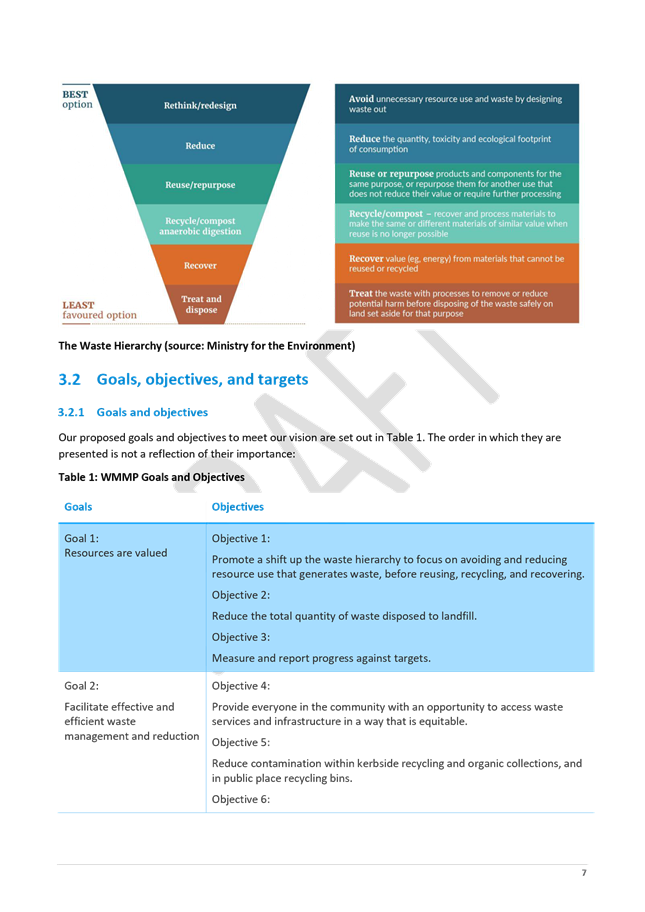









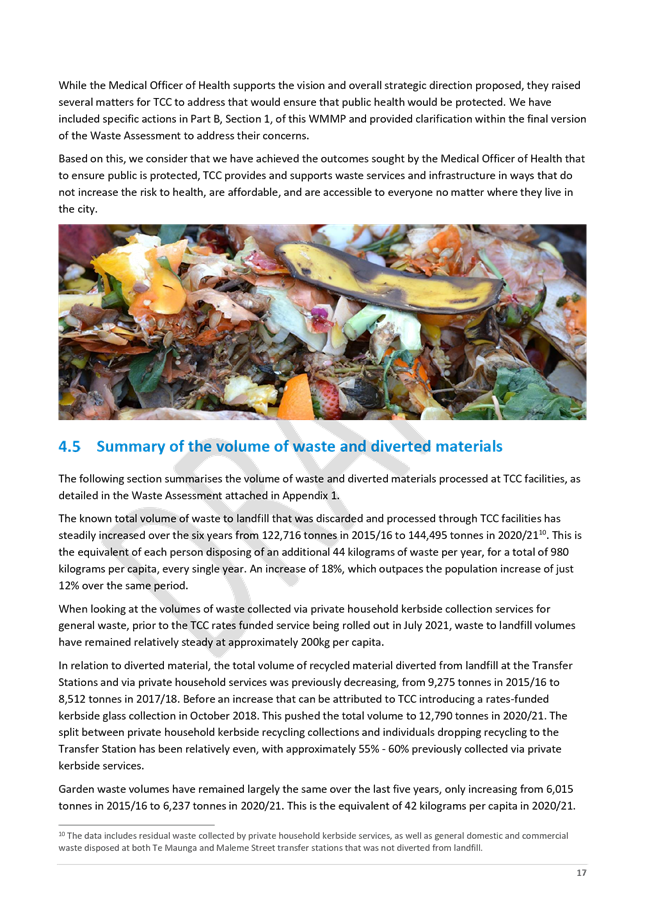













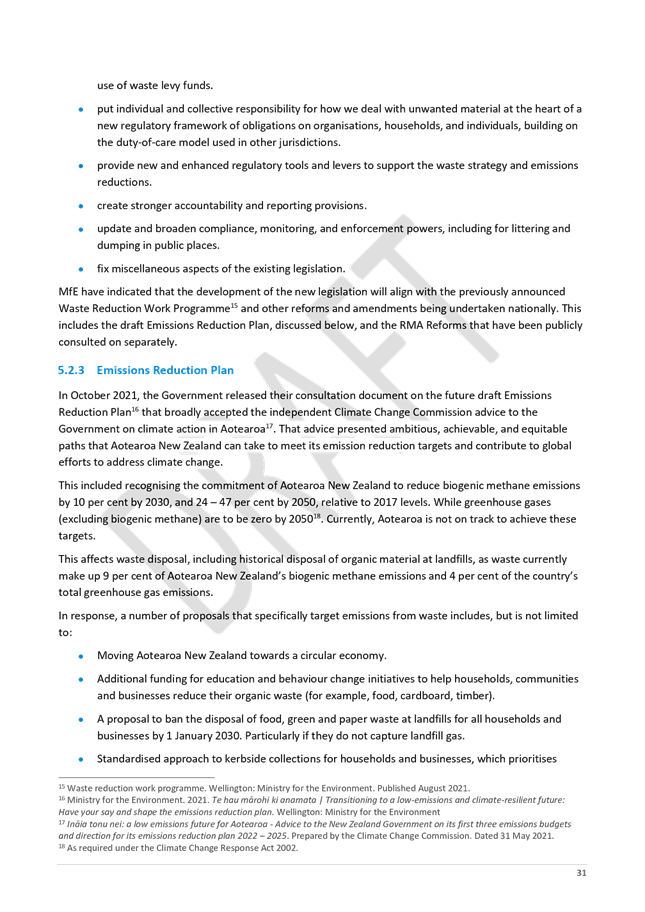



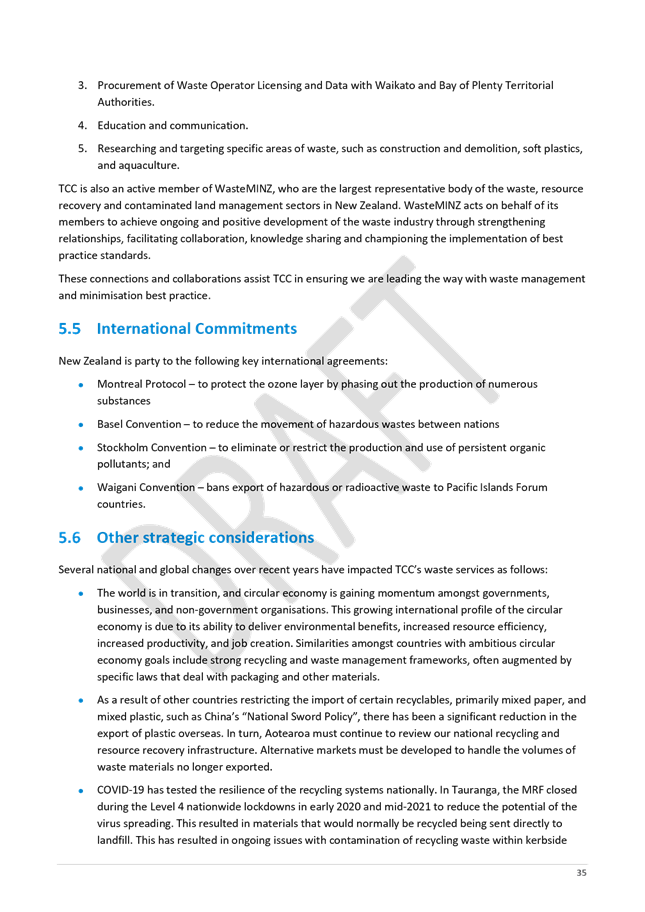

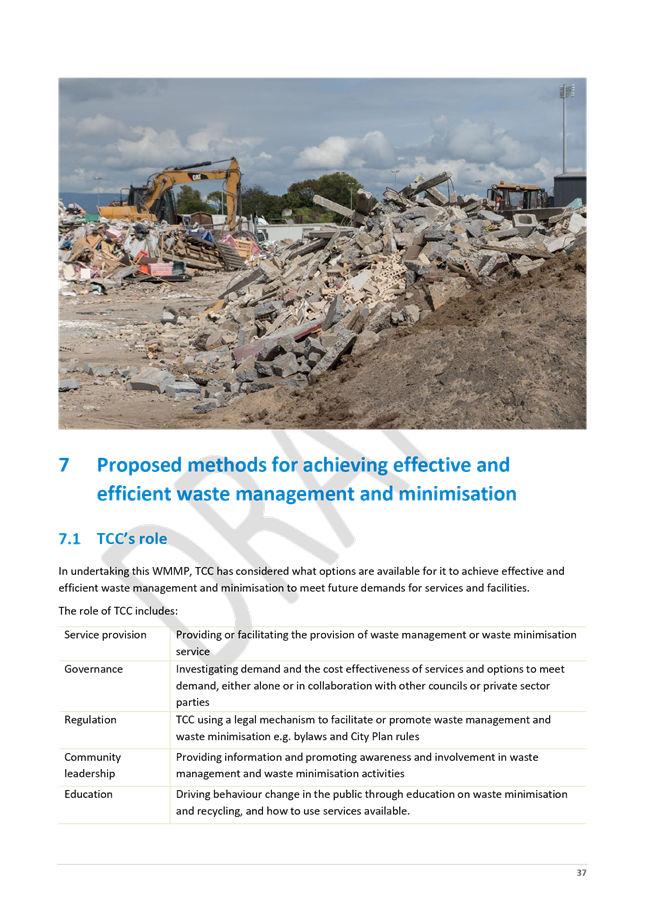

8.9 Q2
2021/22 LGOIMA and Privacy Requests
File
Number: A13240629
Author: Emily
Clarke, Democracy Services Advisor
Kath Norris, Team Leader:
Democracy Services
Authoriser: Tony
Aitken, Acting General Manager: People and Engagement
Purpose
of the Report
1. The
purpose of this report is to update the Committee on Local Government
Information and Meetings Act 1987 (LGOIMA) and Privacy requests for the second
quarter of 2021/22.
|
Recommendations
That the Strategy,
Finance and Risk Committee:
(a) Receives
the report Q2 2021/22 LGOIMA and Privacy Requests.
|
Discussion
2. A
total of 85 requests were received in this quarter. This is more than Q1 with
77 requests received. In Q2 2020/21 there were 61 requests received.
3. The
origin of the 85 requests is broken down in table 1. The type of requests
(LGOIMA or Privacy, or Both) is broken down in table 2.
Table 1
Origin of Requests
|
Type of Requester
|
Number of Requests
|
|
Individual
|
65
|
|
Media
|
6
|
|
Organisation
|
14
|
|
TOTAL
|
85
|
Table 2
Type of Requests Received
|
Type of Request
|
Number
|
|
LGOIMA
|
76
|
|
Privacy
|
7
|
|
Both
|
2
|
4. A breakdown of the business
group allocation for requests received is detailed in the pie graph at the end
of this report.
5. There were four
individuals who made two requests, one individual who made three requests, and
one individual who made nine requests. In addition, the individual who made
nine requests was also associated with three other requests about the same
matter.
6. A total of three
requests were extended, two LGOIMA and one Privacy. All extended requests were
responded to in the extended timeframe.
7. In this quarter, 79
requests were due a response. Of these, 97% were responded to in the statutory
timeframe. Three requests were responded to outside this timeframe due to
workload at the end of November/start of December, a delay in communicating the
request internally, and administrative oversight (closed in error).
8. Three requests
received in Q2 are still pending a response.
9. Following the
Council’s decision to require the public using staffed Council facilities
to be vaccinated on 2 December 2021, there were requests received from 43
individuals. The Democracy Services team served as the contact and response
point for these responses, many of them required more than one. This number is
recorded separately and not reflected in the numbers above.
10. Themes for the quarter are in
table 3 below:
Table 3
General Themes for Quarter Two
|
General Themes
|
Number of Requests
|
Percentage of Total
|
|
Water (including water reforms)
|
7
|
8%
|
|
Commissioner related – i.e., costs, correspondence
|
4
|
5%
|
|
Noise complaints (various
addresses
|
4
|
5%
|
|
Cameron Road Project
|
3
|
2%
|
|
Elder Housing
|
2
|
2%
|
11. The outcome for the 82
requests responded to for Q2 are outlined in table 4 below:
Table 4
Outcome for Requests Responded to in Quarter Two
|
Outcome
|
Number
|
|
Cancelled
|
3
|
|
Partial
Withhold
|
18
|
|
Provided
|
52
|
|
Withheld/Refused
|
9
|
12. All of the Privacy requests
have been responded to.
13. There are currently six open
complaints, all are with the Office of the Ombudsman and have been responded
to, awaiting an outcome. One was received this quarter. There are no current
complaints with the Office of the Privacy Commissioner.
14. Responses that may have
interest to the community continue to be proactively published on the council
website. A number of requests have been resolved quickly as the information is
available online, either through previously published LGOIMA responses or other
locations on our website.
15. The charging policy continues
to be a useful tool to manage requests. We have not charged anyone this quarter
however we have had several requests withdrawn or amended following advice that
a charge would apply. Requests took an average of 2.8 hours of staff time per
requests, not including legal review where required and sign off processes. The
average response time was thirteen working days.
16. Work continues completing the
Ombudsman Investigation recommendations, there are no finalised actions for
this quarter.
Chart – Business Group
Allocation of Requests
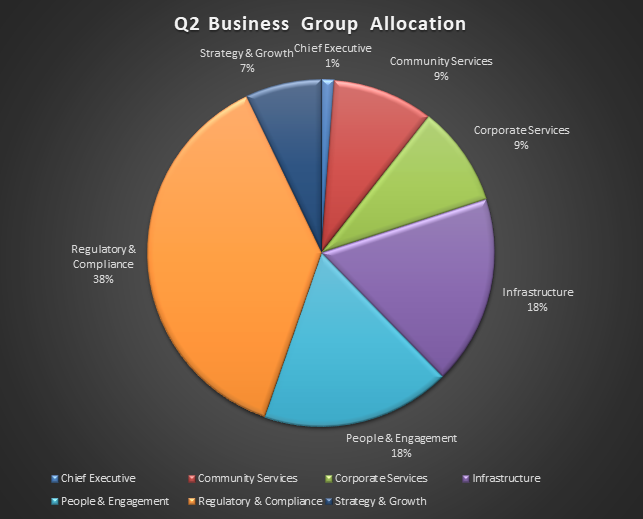
Attachments
Nil
8.10 Three
Waters Reform Update Report
File
Number: A13258871
Author: Cathy
Davidson, Manager: Directorate Services
Dianne Bussey, Contractor -
Three Water Reforms
Authoriser: Nic
Johansson, General Manager: Infrastructure
Purpose
of the Report
1. The
purpose of this report is to provide an update on the work being undertaken and
planned by the Three Waters Reform project.
|
Recommendations
That the Strategy,
Finance and Risk Committee:
(a) Receives the
report Three Waters Reforms Programme update to the end of February 2022.
(b) Notes
the establishment of the following structures to undertake ongoing work
related to the three waters reforms.
(i) Project
Team
(ii) Project
Steering Group
(c) Support the
continuation of Tauranga City Council working with National Transition Unit,
including the responses to information requests, nominations for National
Reference Groups and Entity B Local Transition Team and working alongside
other local authorities in the Entity B region.
(d) Notes the
recommendations of the Working Group on Representation,
Governance and Accountability.
(e) That
the Project Steering Group appraises the recommendations from the Working
Group on Representation, Governance and Accountability report, and reports to
Council how those recommendations respectively respond, or otherwise, to
concerns captured from community, Te Rangapū and commission, in relation
to the original governance proposal.
|
Discussion
2. The Three Waters
Reform project team (project team) has been established and structured to align
with the National Transition Unit (NTU) work stream structure. The
project structure is scalable and will be able to be adjusted as needed to
respond and prepare for the Three Waters reform. Appointments to the
project team have been made progressively, with two external roles (Project
Manager and Change and Communications Manager) funded by DIA’s Crown
infrastructure Partners and have been contracted through to end of June 2022.
The project workstreams are: -
(a) Water Services and Asset
Management – Active
(b) People and Workforce - Active
(c) Finance and Corporate Services
- Active
(d) Information Systems (Data and
Digital) - Active
(e) Compliance and Regulatory -
Inactive
(f) Future Post Reform &
Community Wellbeing - Inactive
3. Project governance
and direction has been provided by a Project Steering Group, which has been
meeting monthly since late 2021. This approach has enabled Tauranga City
Council to be in an excellent position as NTU commences their discovery process
and information requests from councils.
4. The Department of
Internal Affairs (DIA) have provided a letter responding to council feedback
post the eight-week consultation period ending September 2021. The letter
includes an update on the Three Waters Reform Programme including where council
feedback has resulted in changes and detailed responses to council’s
specific questions. See Appendix A – Three Water Reform Feedback
Relation to 8 Week Engagement Period.
5. DIA established a Representation,
Governance and Accountability Working Group to review the key issues that arose
from the consultation process completed in September 2021. A draft Water
Services Entities Bill was made public to support the deliberations of this
group. The working group heard from submitters about alternative governance
and representative models and representation principles and has now completed
the deliberative phase and has recently announced their feedback to Government.
(a) The summary of the Working Group’s
47 recommendations are as follows: -
(i) Strengthen community
ownership of assets, and protection from privatisation, through a public
shareholding structure where councils hold shares on behalf of their
communities.
(ii) Strengthen the local voice,
with new mechanisms to strengthen the role of the new Regional Representative
groups (RRGs) through the establishment of advisory Groups (sub-RRGs) that will
feed into the larger body.
(iii) Recognising Te Mana o te Wai
as an underlying principle of all aspects of the reforms to underpin the Water
Service Entity (WSE) framework.
(iv) Ensure the continued improvement of
Three Waters service delivery and environmental protection through increased
representation of our communities, including iwi/hapū, with co-governance
as a central principle.
(v) Government to give fresh
consideration to its ongoing communications and engagement with the public to
build understanding of both the direct impact and the broader context of the
Three Waters reforms.
(b) The Minister has advised a
review will now be undertaken of all the Working Group recommendations and
changes to the draft legislation be developed. A copy of the executive summary
can be accessed via the following link. https://www.dia.govt.nz/diawebsite.nsf/Files/Three-waters-reform-programme-2022/$file/Governance-Working-Group-Report_Executive-Summary.pdf
(c) The project team will provide
further detail and analysis of the recommendations from this report to Council
in the 2nd quarter of this year.
(d) It is expected that the Water
Services Entities Bill will be introduced to parliament in the second half of
the year.
6. NTU issued a Transition
Information Pack on 20th
January 2022. Whilst the transition pack did not contain significant new
information, confirmation of the high-level principles and signalling the
upcoming requests for information were helpful to enable the project team to
ensure their focus was consistent with NTU advice.
7. The first request
for information from the NTU People and Workforce workstream has subsequently
been completed within the timeframes requested. The RFI requested
information around positions with water facing accountabilities, as well as the
roles/services that are being outsourced.
8. Advice has been
received that a request for information focusing on the data and digital
environment is about to be released from the NTU. That is expected in the week
commencing 21 March. The information to be provided (current state of systems,
operational technology, data volumes and IT capabilities) will assist the NTU
with detailed scoping, estimating the work required and resource
planning. It will also help in preparing business cases to go to
Treasury. It will allow an understanding of potential day one readiness of
operational technology and identify any gaps that need to be addressed. Some
limited funding will be provided by NTU to support local government where
necessary to respond to requests such as this. Details of that funding is still
being finalised.
9. NTU have advised
that further RFIs will be requested during Q1 2022.
(a) Asset data standards and asset
information
(b) Investment prioritisation
criteria
(c) Catalogue of systems,
capabilities and external contractor information
(d) Pricing/tariff information
– only requested from a sample of councils
(e) Financial information –
Debt, revenue and reserves
(f) Shareholdings in
relevant CCOs, premises and land information, warrants and delegations.
10. NTU have increased the level
of communication with local authorities in 2022. Starting in January,
workstream meetings with Three Waters Reform resources from Hamilton City
Council and Tauranga City Council were held with NTU. People and
Workforce, Data and Digital, Asset Management Operations and Stormwater (AMOS)
and Finance and Corporate Services workstream meetings were held, which has
established working relationships and a better understanding of roles and
responsibilities. NTU have advised an intention to hold fortnightly webinars,
the first webinar was presented on 23rd February.
11. A number of representation
opportunities have been identified by NTU at both a national and local
level. The project sponsors approved the following nominations in
February: -
(a) Transition Reference Groups
(TRG)
(i) People
and Workforce - Wally Potts
(ii) Finance
and Corporate Services - Mohan de Mel
(iii) Asset Management, Operations
and Stormwater – Stephen Burton
(b) Entity B Local Transition Team
(LTT) – Stephen Burton
(c) Kelvin Hill has been invited
to join the Stormwater Reference Group
Wally Potts has
subsequently been confirmed as a member of the People and Workforce TRG,
further appointments are expected in the coming weeks.
Data and Digital
national working groups have just been announced seeking council and sector
involvement in (1) Data Governance, and, (2) Architecture / ICT National
Working Groups. Project Sponsors will appraise our organisation’s
best fit for these two working groups, and nominate Tauranga City Council
representatives.
It
is anticipated that further representation opportunities will be provided over
the next quarter as NTU continue to establish national workstreams and the
Local Transition Team is developed.
12. Stephen Burton has confirmed
that he will be completing his 6-month secondment with the NTU at the end of
March and returning to TCC. His focus has been on setting up the structure,
focus and timeline for the national operations workstream. This workstream is
part of the overall AMOS workstream. Stephen’s focus will be within
the Three Waters Reform transition for TCC.
13. The NTU will be providing
support to the LTT for facilitation, secretariat and project management and are
seeking funding to cover the costs to backfill Council staff to enable them to
actively participate in the transition work.
14. NTU have advised that work is
continuing across the NTU workstreams including: -
(a) Confirmation and guidance on
the criteria to enable initiatives to access the ‘Better Off’
funding. Applications open in March to August, with the first tranche of
funding (for TCC $12,101,254 - 25% of $48 million) being made available from 1
July.
(b) Iwi engagement/partnership
approach.
(c) Comms & engagement
strategy.
(d) External Advisor Procurement
strategy.
(e) Sector Engagement strategy.
(f) Nominations for
workstream technical groups.
(g) Treasury funding drawdown.
(h) Transition funding assistance
for councils.
(i) Establish Local
Transition Teams.
Next Steps
15. Over
the next two months, the project team will be focusing on the following:
-
(a) Confirmation and
implementation of internal engagement approach.
(b) Working with NTU on
understanding transition roles and responsibilities and expectations of TCC.
(c) Determining legislative and
change impacts, as a result of the Working Group on Representation, Governance
and Accountability recommendations.
(d) Analysis of recommendations
made by Working Group on Representation, Governance and Accountability
identifying how they respectively respond to concerns from the Tauranga community,
Te Rangapū and Commission.
(e) Responding to NTU Discovery
requests for information.
(f) Iwi engagement strategy.
(g) Confirmation and
implementation of approved risk controls.
(h) Supporting the establishment
of the Entity B Local Transition Team.
(i) Continuing discussions
with other councils within Entity B region, looking for opportunities to work
together.
Attachments
1. Appendix
A – Three Water Reform Feedback Relation to 8 Week Engagement Period -
A13296282 ⇩ 
|
Strategy, Finance and Risk
Committee Meeting Agenda
|
28 March 2022
|






10 Public
excluded session
RESOLUTION TO
EXCLUDE THE PUBLIC
|
Recommendations
That the public be
excluded from the following parts of the proceedings of this meeting.
The general subject
matter of each matter to be considered while the public is excluded, the
reason for passing this resolution in relation to each matter, and the
specific grounds under section 48 of the Local Government Official
Information and Meetings Act 1987 for the passing of this resolution are as
follows:
|
General subject of each matter to be
considered
|
Reason for passing this resolution in
relation to each matter
|
Ground(s) under section 48 for the
passing of this resolution
|
|
10.1 - Quarterly Security Report - Q4
2021
|
s7(2)(c)(ii) - The withholding of the information
is necessary to protect information which is subject to an obligation of
confidence or which any person has been or could be compelled to provide
under the authority of any enactment, where the making available of the
information would be likely otherwise to damage the public interest
|
s48(1)(a) - the public conduct of the relevant
part of the proceedings of the meeting would be likely to result in the
disclosure of information for which good reason for withholding would exist
under section 6 or section 7
|
|
10.2 - Corporate Risk Register -
Quarterly Update
|
s7(2)(b)(i) - The withholding of the information
is necessary to protect information where the making available of the
information would disclose a trade secret
s7(2)(b)(ii) - The withholding of the information
is necessary to protect information where the making available of the
information would be likely unreasonably to prejudice the commercial
position of the person who supplied or who is the subject of the
information
s7(2)(h) - The withholding of the information is
necessary to enable Council to carry out, without prejudice or
disadvantage, commercial activities
s7(2)(i) - The withholding of the information is
necessary to enable Council to carry on, without prejudice or disadvantage,
negotiations (including commercial and industrial negotiations)
|
s48(1)(a) - the public conduct of the relevant
part of the proceedings of the meeting would be likely to result in the
disclosure of information for which good reason for withholding would exist
under section 6 or section 7
|
|
10.3 - Internal Audit - Quarterly
Update
|
s6(b) - The making available of the information
would be likely to endanger the safety of any person
s7(2)(a) - The withholding of the information is
necessary to protect the privacy of natural persons, including that of
deceased natural persons
s7(2)(d) - The withholding of the information is
necessary to avoid prejudice to measures protecting the health or safety of
members of the public
s7(2)(g) - The withholding of the information is
necessary to maintain legal professional privilege
s7(2)(j) - The withholding of the information is
necessary to prevent the disclosure or use of official information for
improper gain or improper advantage
|
s48(1)(a) - the public conduct of the relevant
part of the proceedings of the meeting would be likely to result in the
disclosure of information for which good reason for withholding would exist
under section 6 or section 7
|
|
10.4 - Litigation Report
|
s7(2)(a) - The withholding of the information is
necessary to protect the privacy of natural persons, including that of
deceased natural persons
s7(2)(g) - The withholding of the information is
necessary to maintain legal professional privilege
s7(2)(i) - The withholding of the information is
necessary to enable Council to carry on, without prejudice or disadvantage,
negotiations (including commercial and industrial negotiations)
|
s48(1)(a) - the public conduct of the relevant
part of the proceedings of the meeting would be likely to result in the
disclosure of information for which good reason for withholding would exist
under section 6 or section 7
|
|





























































































































































































































































































